THE LAND OF SŁUPSK
SŁUPSK
Town Hall
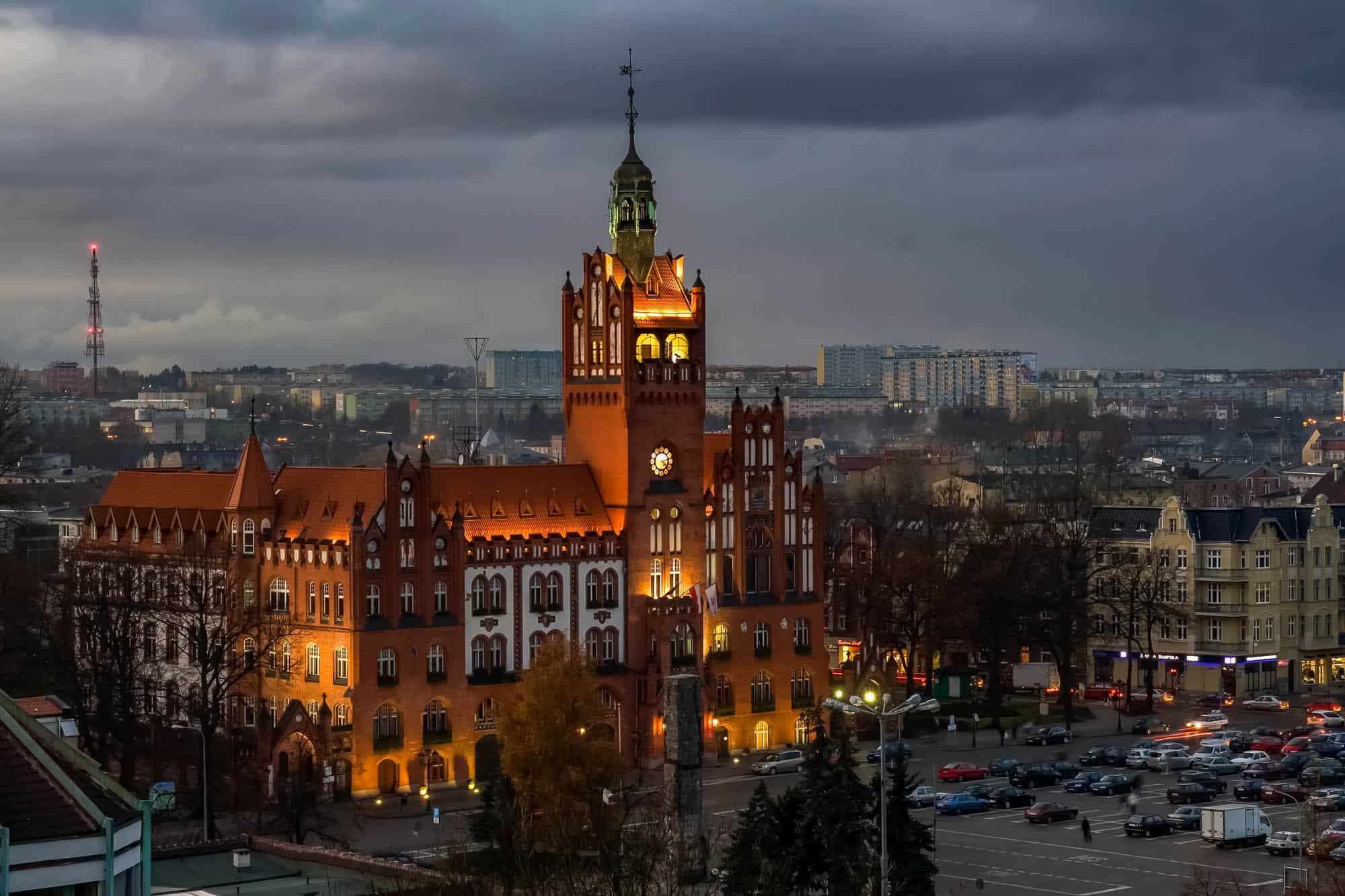
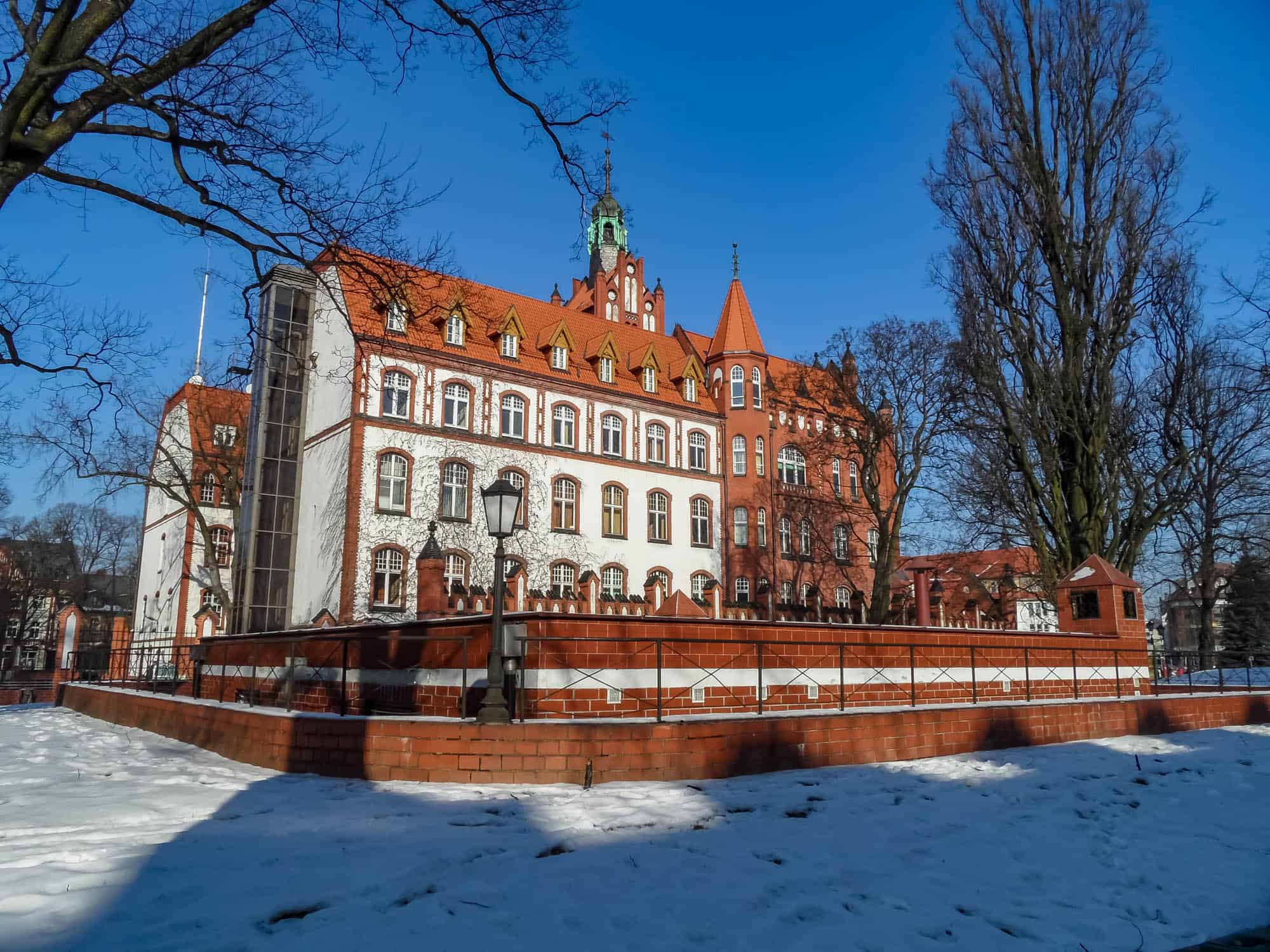
The Building of the County Starost Office
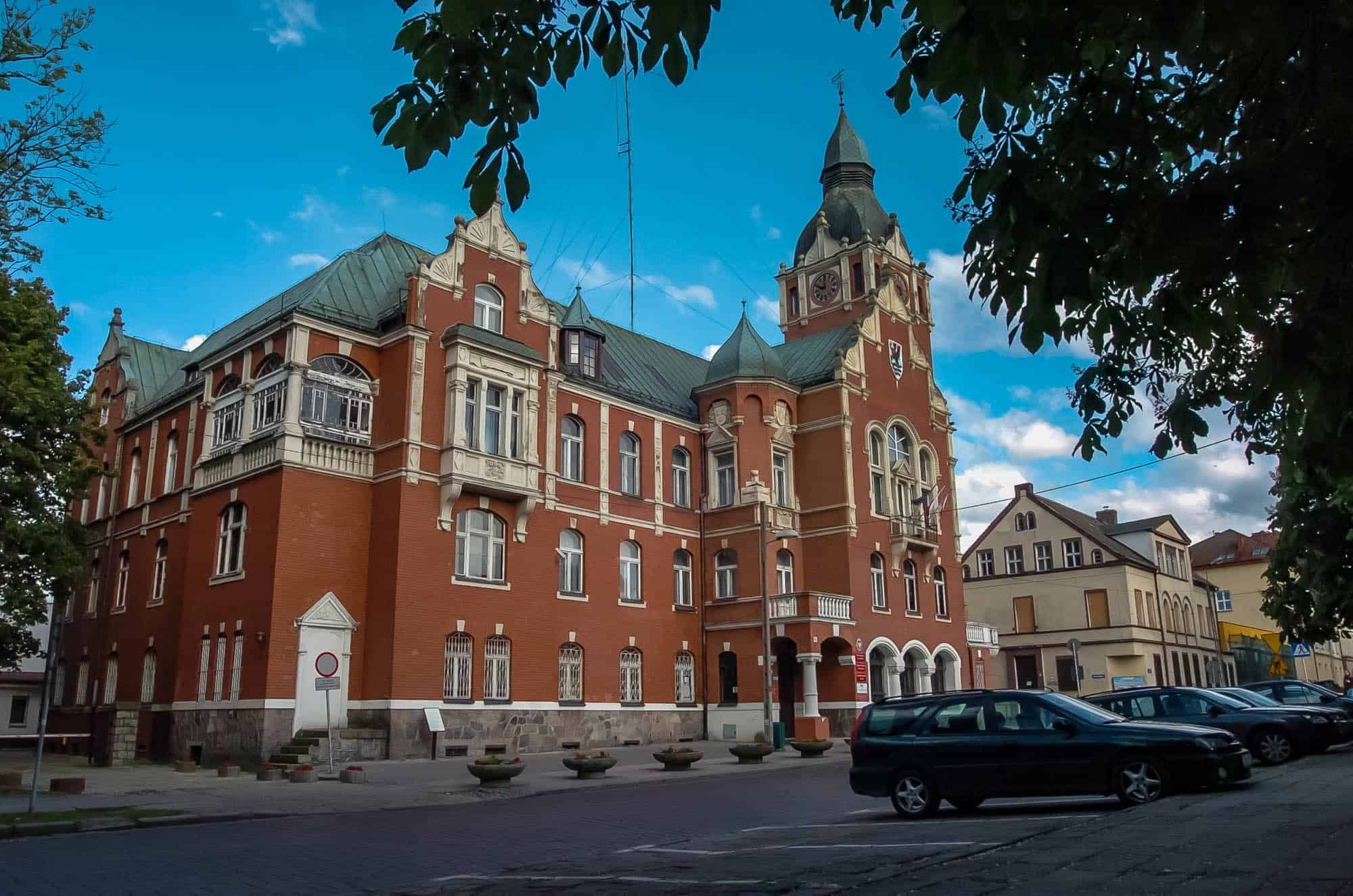
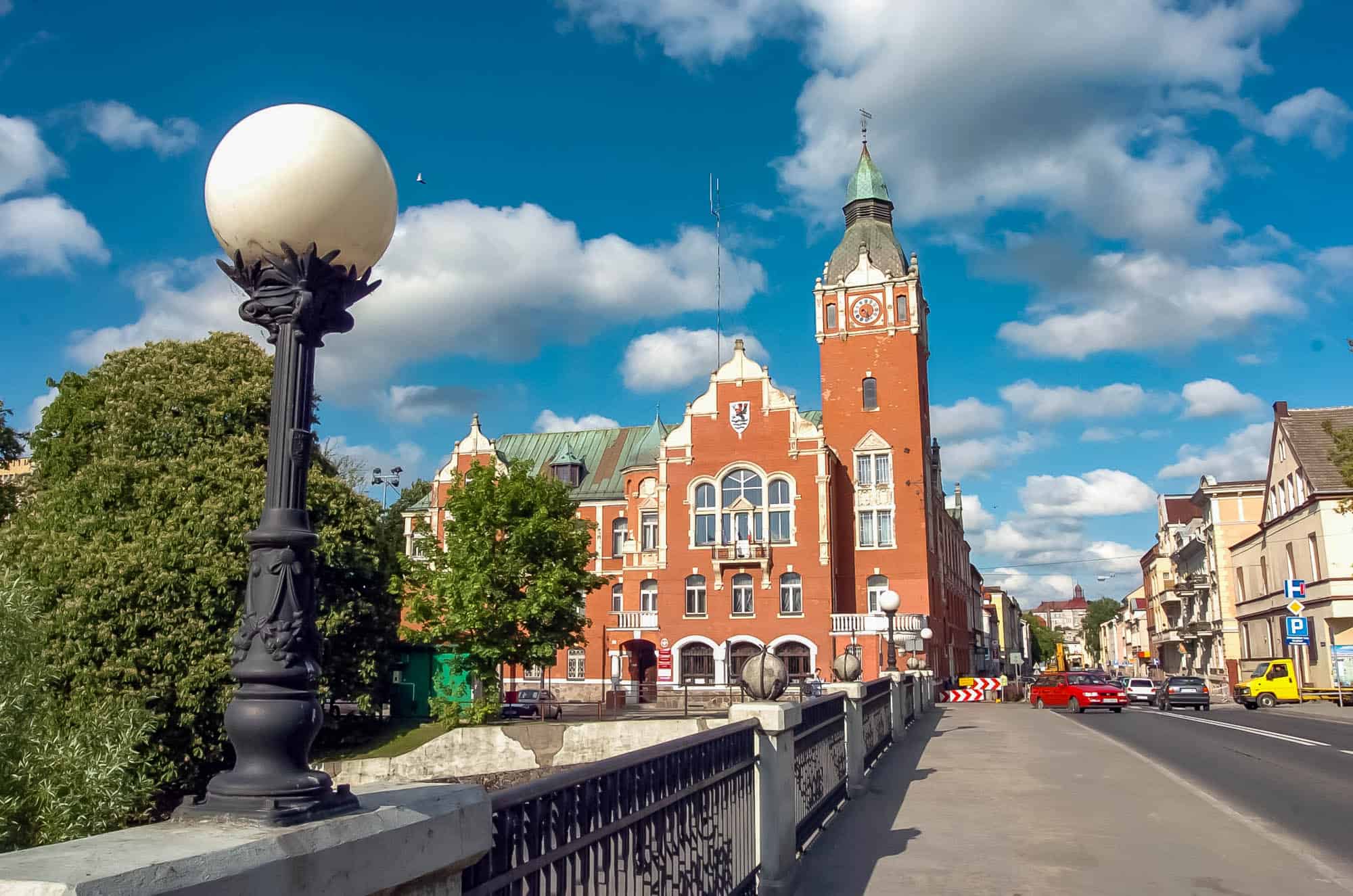
One of the most beautiful buildings in Słupsk from around 1903.
The building housed the County National Council, and after the Słupsk Voivodeship was established, also the headquarters of the Provincial Office and the National Voivodship Council. Based here are currently the County Office as well as the Administration of the Słupia Valley Landscape Park. The elevations were made of face brick, and decorations surrounding the window openings, balconies, gables were made of sandstone. The dominant accent of the building is the clock tower topped with a cupola with a lantern. Interestingly, the regional government office is at the same distance of 280 meters, measured in a straight line, from the 13th-century St. Mary’s Church, as is the Town Hall. It is no coincidence, but rather an intended effect of German town planners. This fact is not without significance. Both objects definitely distinguish themselves in the entire urban layout of the city. Both were built almost in the same period.
Since the beginning, the Starost’s Office was built to meet the needs of the local authorities and it fulfills such a role, with small breaks in times when there were no counties in Poland, to this day. In the years 1975–1989, when Słupsk did not have a modern office building at today’s Jana Pawła II Street, it was also the seat of the Provincial Office, Provincial National Council, and in the years 1990–1998 the District Office. In 1999, counties returned to the map of Poland and the building once again served the authorities of the Słupsk County. Incredible though it may seem, but the structure with an area of 840 square meters and a shape similar to the letter “U”, with numerous ornaments and a nearly 40-meter tower was built in just 18 months! In May 1902, construction works began, on November 21, 1902, the so-called topping out ceremony took place, and on November 6, 1903, the finished building was ceremonially transferred to the authorities of the then county.
Pomeranian Dukes’ Castle
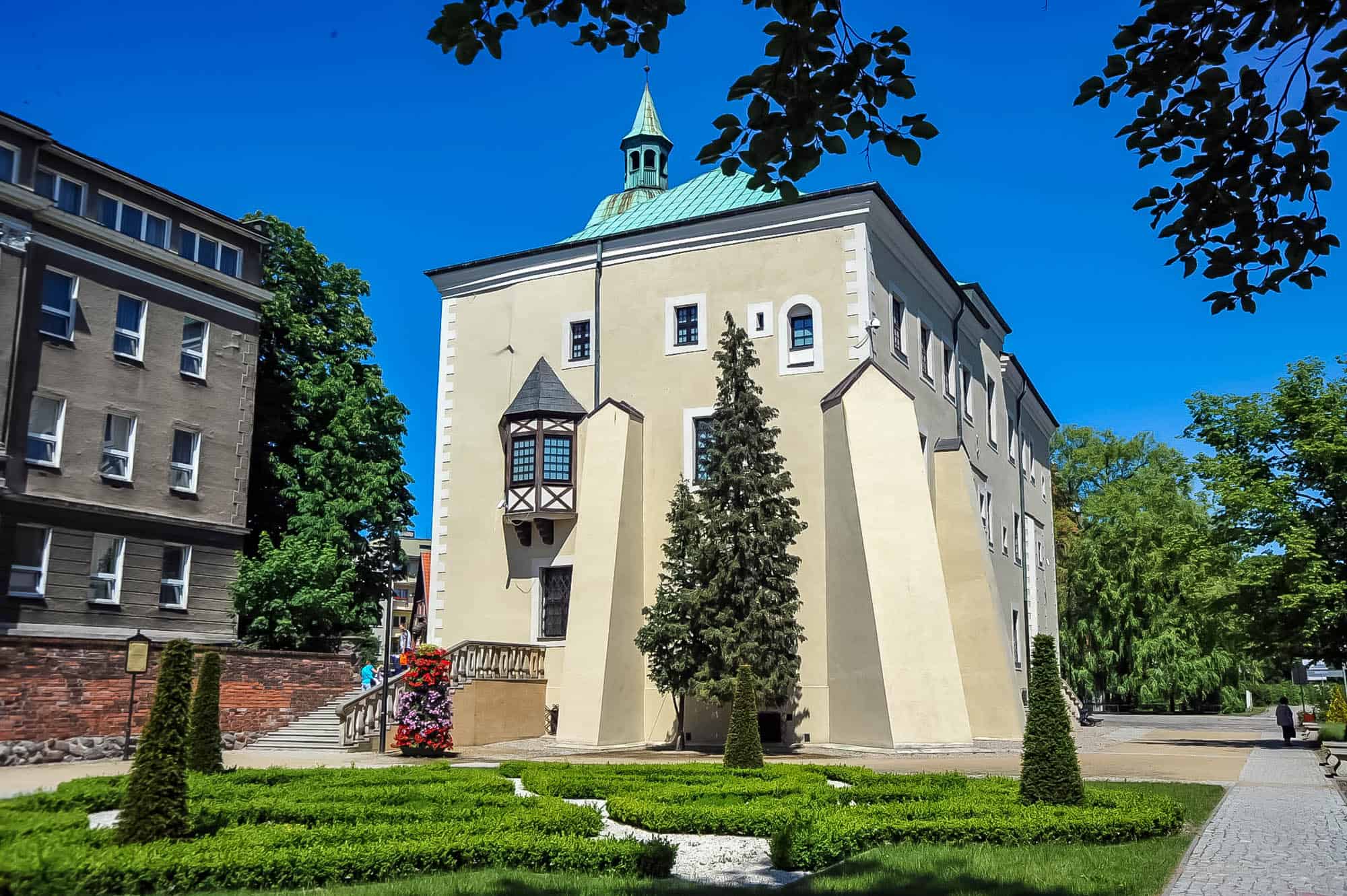
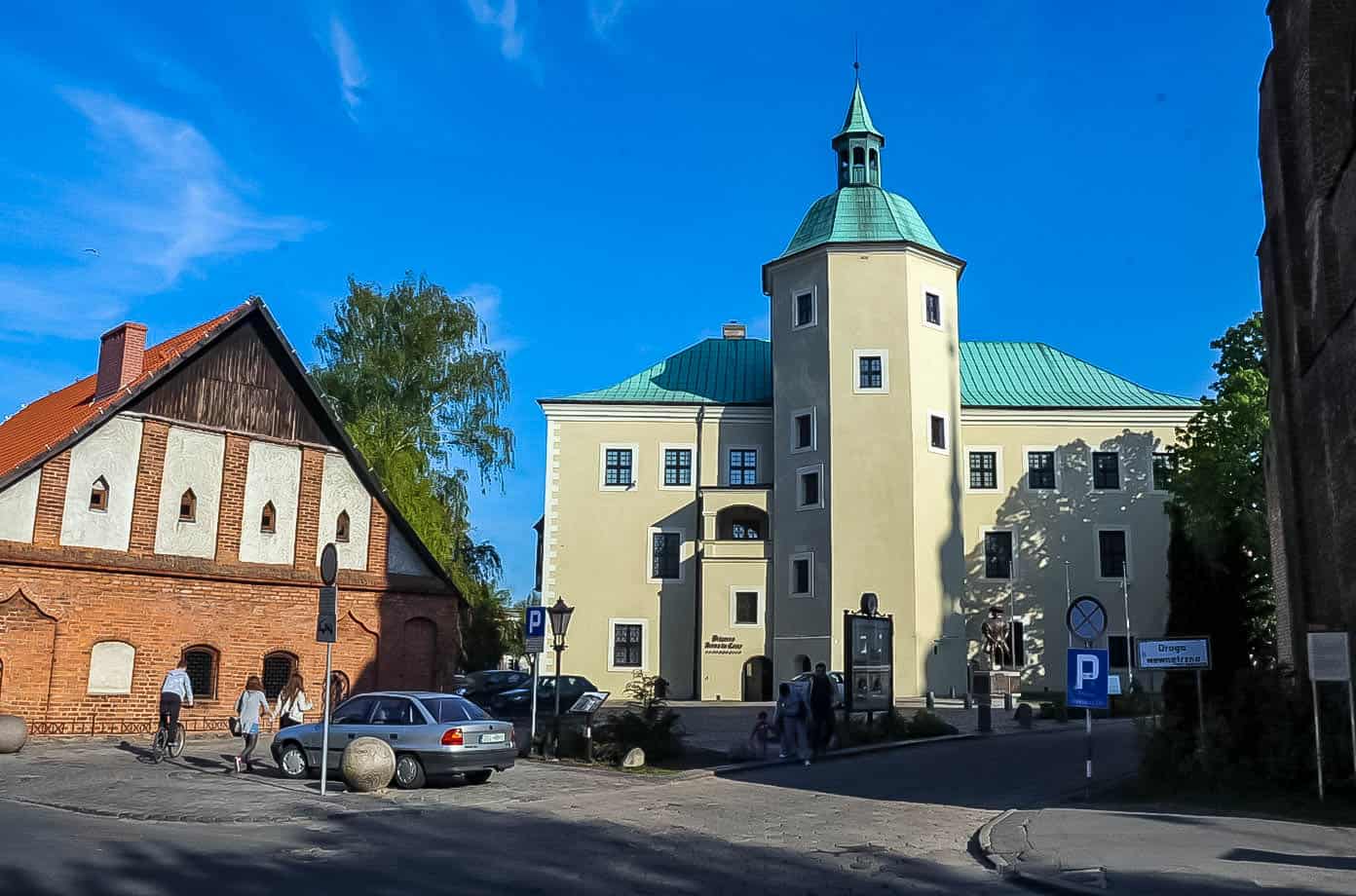
The building currently hosts the Museum of Central Pomerania. It was constructed in 1507 by prince Bogusław X. Initially, the structure was a gothic building. After the reconstruction, it was converted into Renaissance style. In the past, the castle was the residence of Pomeranian princes from the Griffin dynasty. Later, during the German rule, it served as a grain and weapons warehouse, and a prison. This use contributed to its considerable devastation.
The building was renovated only after the Second World War. Among other things, the head of the castle tower was rebuilt. Despite many damages, it retained its original dimensions and finish. The castle is situated in the vicinity of the Słupia River, within the former medieval Słupsk stronghold. The so-called castle complex consists of: the castle itself, the timber framed building of the Administration of the Museum of Central Pomerania, the Castle Mill, the Fisherman’s Gate and recently, the White Granary. In the immediate neighborhood there is also Richter’s Granary, an object moved piece by piece from its original location at the intersection of Kopernika and Wolności Streets. In the close vicinity there is also the historic St. Jack’s Church which, according to some legends, can be accessed through underground corridors from the castle. The castle mill is one of the oldest active industrial facilities in Poland. In front of the structure there is a monument to Bogusław X. On the premises of the castle complex, every year in the summer season the traditional Griffin’s Fair is held.
St. Mary’s Church
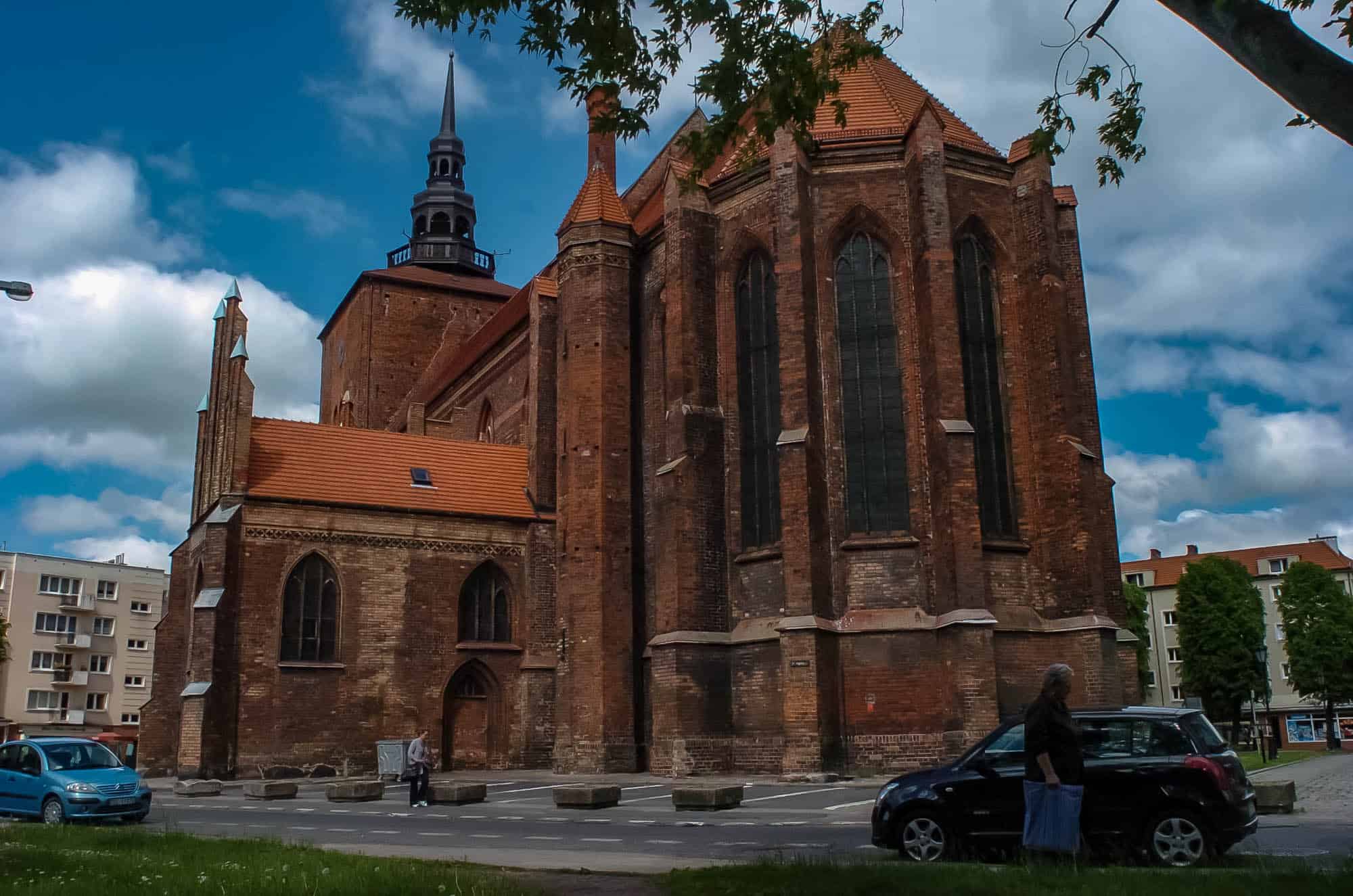
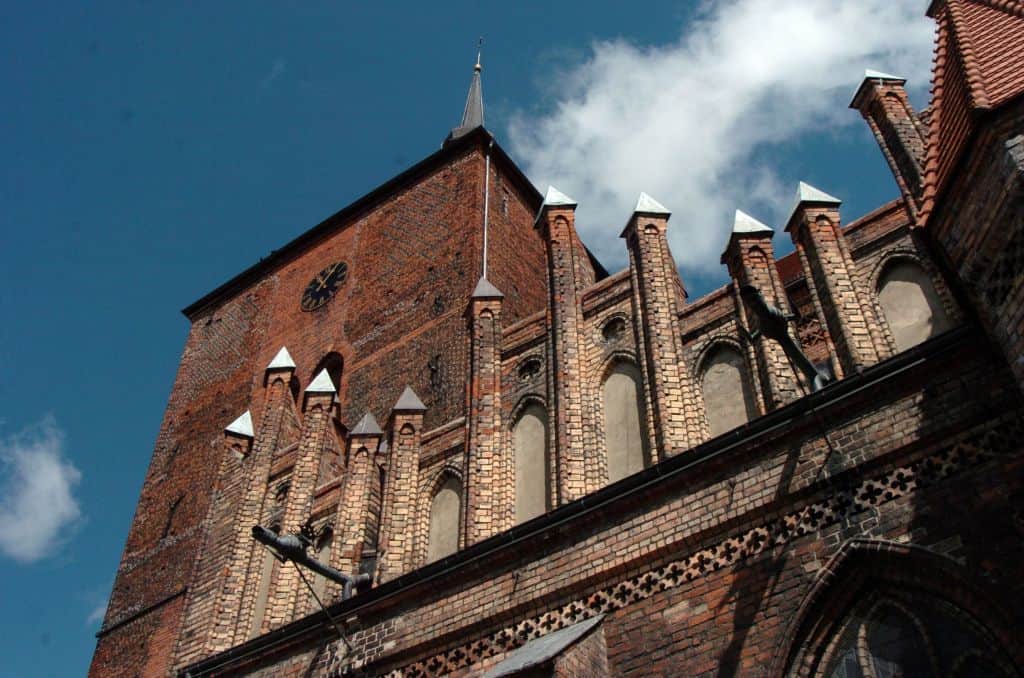
The estimated date of construction is the 14th century. It was then that the authorities of Słupsk, developing on maritime trade in the nearby Ustka, decided to build a new church. However, it is acknowledged that earlier, on the site of the church which exists currently, there was another temple. However, the exact time of construction of the earlier temple is unknown. Since the outset, this church served the German municipality. Around 1500, St. Mary’s Church was considerably expanded. In 1525, during the riots associated with the introduction of the Reformation in the city, an agitated crowd burst into the church, destroying its furnishings, including the altar, statues of saints and pictures. Through ages of its existence, the church was unceasingly rebuilt and modernized. It was destroyed during World War II but was profoundly rebuilt in the years 1945–1948. The last modernization works were carried out in 2003, when a replica of the spire-steeple was installed on the church tower. One of the most precious monuments of the temple is the late Renaissance pulpit, made in the years 1609–1630 by Paweł Waltersdorf, a woodcarver from Słupsk.
An unheard-of fact is hidden in the nearly 50-meter tall church tower. Indeed, it is apparent that the tower is not only one of the largest objects in Słupsk, but is also deflected from the axis by almost 100 centimeters. The tower’s deflection was tested in 2009. It is the only such curved object in Pomerania that stands to this day.
The Witches’ Tower
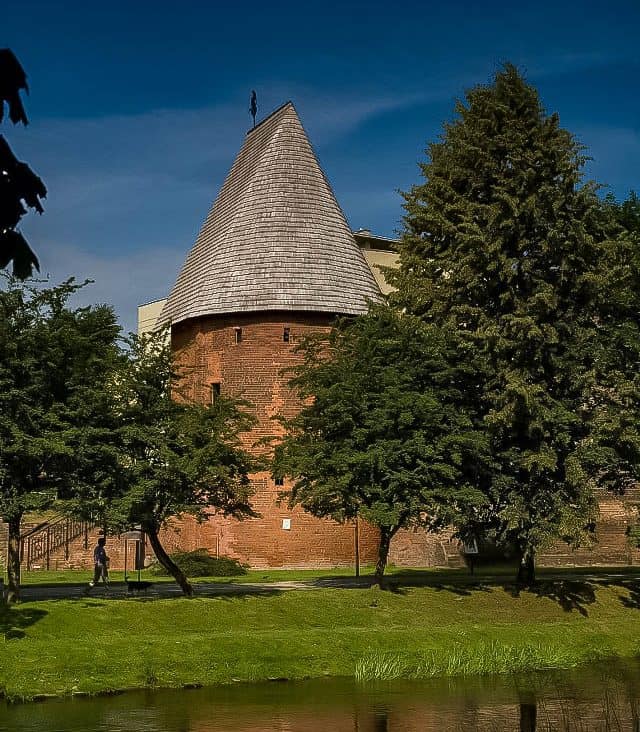
The Witches’ Tower was built around 1415.
It inherited its name only after the events of the 17th century, when it functioned as a prison and site of burning of women accused of witchcraft. The Tower is one of the elements of defensive walls which surrounded Słupsk. Elements of the walls are still preserved today. The place where the Tower is located today was originally probably the site of the shooting porch. Later, prison cells were built in the facility. As we know from the chronicles of the 17th century, in Słupsk there were numerous trials of women accused of witchcraft, most often ending with the burning of the accused at the stake. The last of the victims considered a “witch” was Trina Papisten, a resident of Słupsk, burnt in 1701.
In the 19th century, the Tower was used as a warehouse and then adapted for housing purposes. Damaged during the war in March 1945, it was secured, and then in 1971–1975 rebuilt and adapted to serve exhibition purposes. Currently, the facility is managed by the Baltic Gallery of Contemporary Art. The trademark of the tower is a witch-shaped weather vane on the roof. The tower is located on Francesco Nullo Street.
The Mill Gate and The New Gate
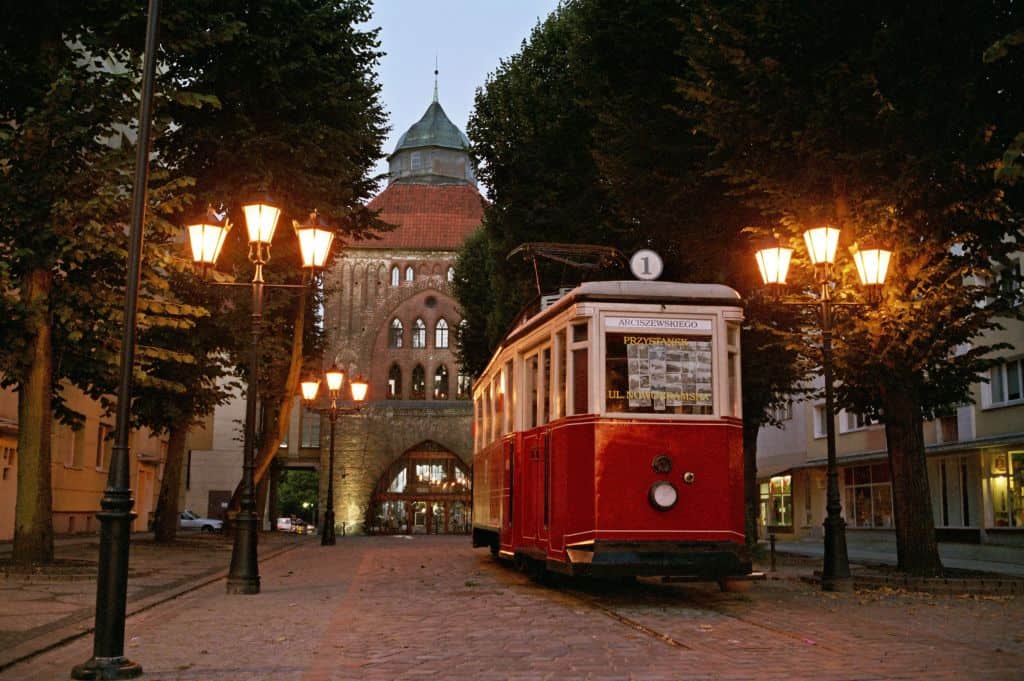
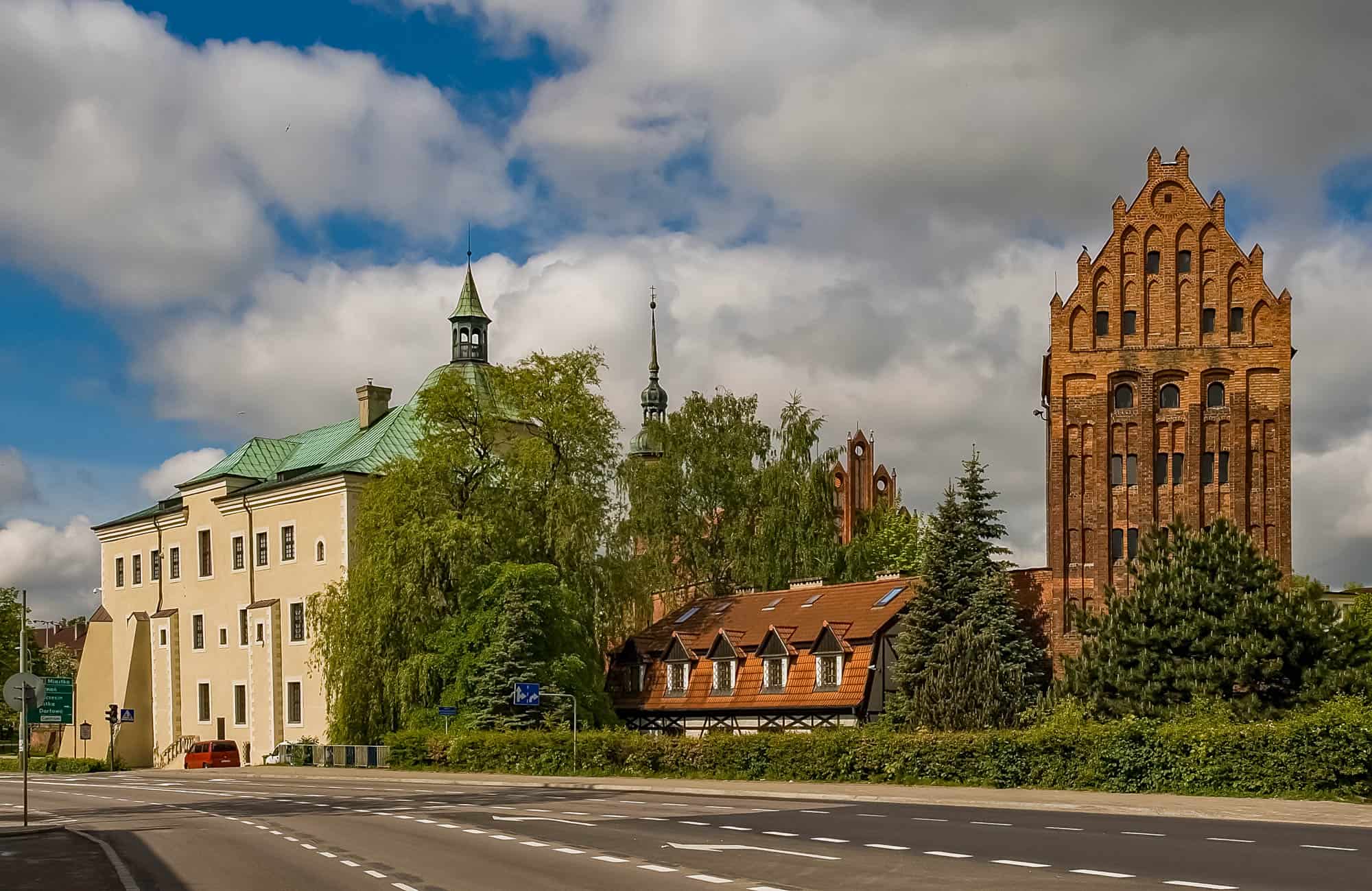
The only roads that could be used to enter or leave the stronghold on Słupia led through the gates. Their creation is dated to the 14th century. In 1834, the Powder Tower was dismantled and in 1867 – the Holstein Gate. The Mill Gate (located in the vicinity of the Pomeranian Dukes’ Castle) closed off the entrance to the city from Gdańsk and Smołdzino. It was built in Gothic style. The gate was covered with decorative gables with pinnacles. During the military actions in March 1945, the gate was destroyed – it lost the ceilings, roof and gables. General restoration and adaptation took place in 1980. A short section of the city’s defensive wall adjoins the southern facade of the Mill Gate. This fragment is the highest preserved in Słupsk and is 8 meters high. It houses the conservation workshop of the Museum of Central Pomerania.
The New Gate (located at Anna Łajming Street) closed the entrance to the city from the direction of Sławno, Darłowo and Szczecin. It was built much later than the Mill and Holstein Gates. For that reason, is was called the New Gate. In the years 1724–1755, the New Gate became the site of a penal prison and a Forced Labor House. In 1836, the passage was widened and the western facade of the gate was renovated. From the mid-19th century to World War I, the gate was used as a military workshop. In 1924, after renovation and adaptation works, a regional museum was located here. The gate served as a museum until 1965. This year, the seat of the museum was moved to the restored Pomeranian Dukes’ Castle. After the conservation and adaptation works, the “New Gate” Art Workshop Gallery was located in the gate.
St. George Chapel
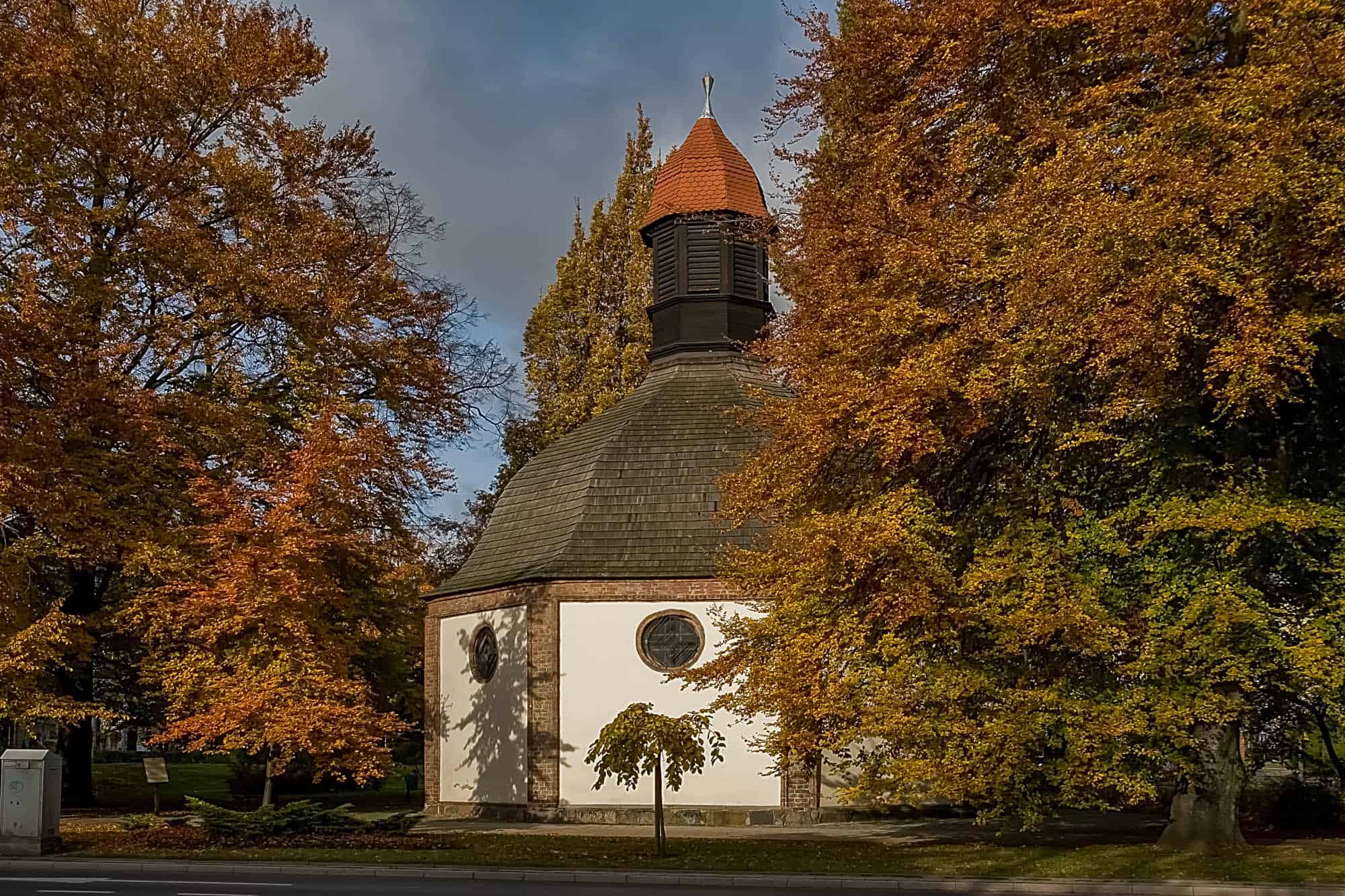
It was initially located at the hospital near today’s Tuwim Street in Słupsk. The chapel was moved to its current location, to the park at Zamkowa Street in 1912. St. George’s Hospital was built for the poor townsfolk, unable to pay a fee required by the sick, isolated here during the pandemic. The first message about the intended construction of St. Goerge’s Hospital comes from 1311, while the chapel itself is mentioned in 1492. After the Reformation, the chapel was largely neglected, and only the renovation in 1610 enabled religious services to be resumed. In 1681 the temple burnt down. Perhaps the vault perished then, and was replaced in 1689 with a wooden one, domed, with a new roof. In such form, it has essentially survived till this day. In 1960, protective works were carried out: the roof structure was repaired and the tiles were replaced with shingles.
It is worth adding that there is no source data on the time when the chapel was built. The date indicated above is not unambiguous. To what extent the reconstruction on the new site of the demolished building respected the original form – it is difficult to say with certainty, as the old descriptions and inventory lack detail.
St. George’s Church
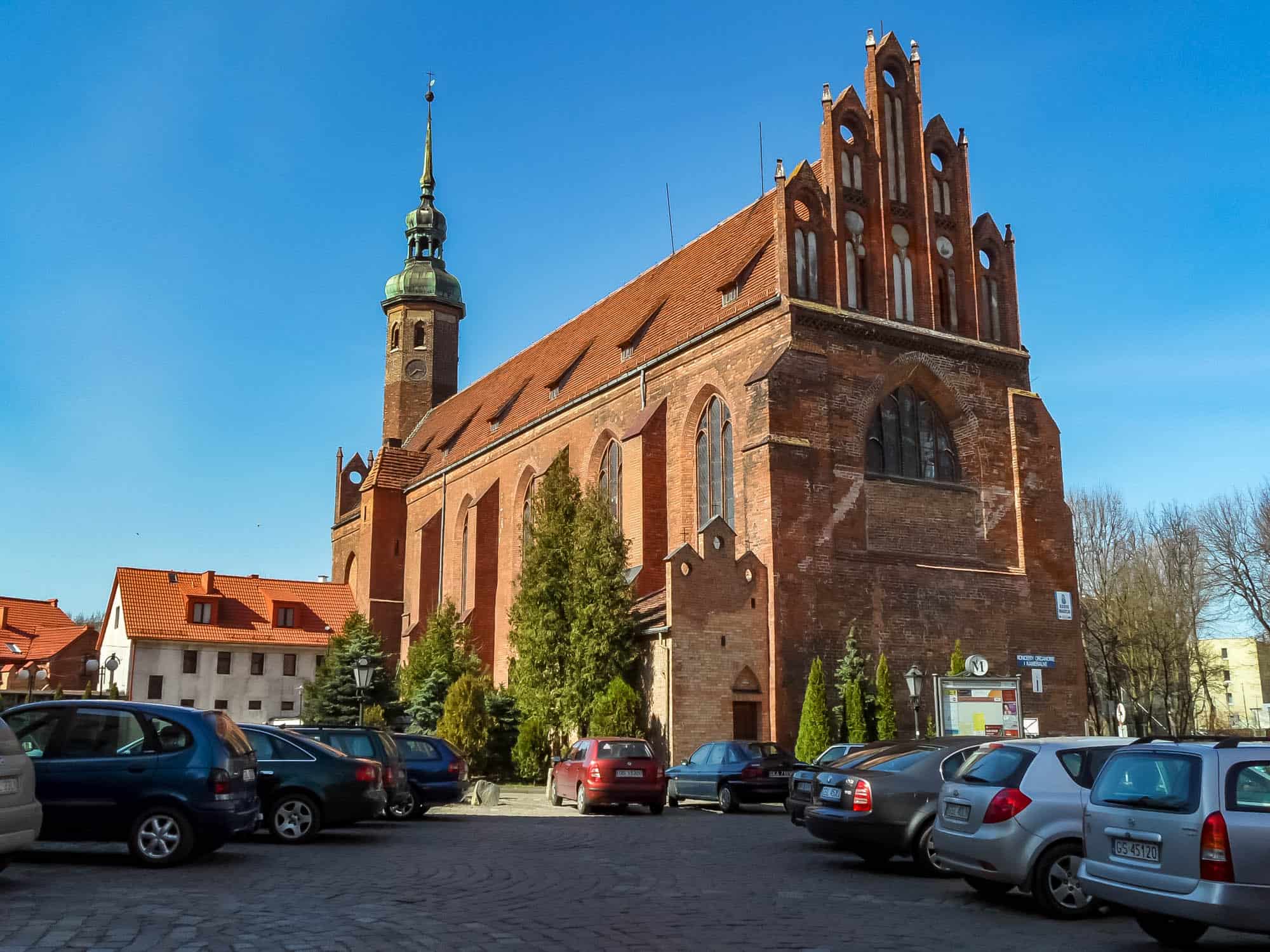
Originally, the monastic buildings were located near the city, but as a follow-up to the territorial development of Słupsk and its relocation, the area allocated to the Dominicans was set within the city. A major part of the church was probably built before the fire of 1477 which consumed nearly the entire Słupsk, and perhaps even the monastery church. The original church, in accordance with the requirements of Mendicant Orders, such as the Dominicans, had no tower but only a flèche, in which a bell was placed. The present gothic church dates from the beginning of the 15th century. At that time, it was a monastic church until 1525. This was the year when, during the riots associated with the introduction of the Reformation, the crowd raided the monastery, demolishing and plundering it, and the interior of the church was burned. After this incident, the Dominicans departed from the city. The preserved crypt under the main altar was formerly where the sarcophagi with the ashes of Princess Anna and her son Ernest Bogusław were placed. These sarcophagi were excavated in 1976 and subjected to conservation, and now they are exhibited at the Museum of Central Pomerania.
In the presbytery, amongst the recess of the south-eastern wall, there is a baroque tombstone of prince Ernest Bogusław de Croy from 1682. The framing of the recess is made of two atlases supporting the entablature of black marble – inside there is a kneeling figure of the prince made of white marble, and deeper there are oval medallions with inscriptions. The tombstone is crowned with the prince’s coat of arms and other decorative and symbolic elements. The church also contains historic, baroque organs, which was founded in the 17th century by prince Ernest Bogusław de Croy.
Defensive Walls
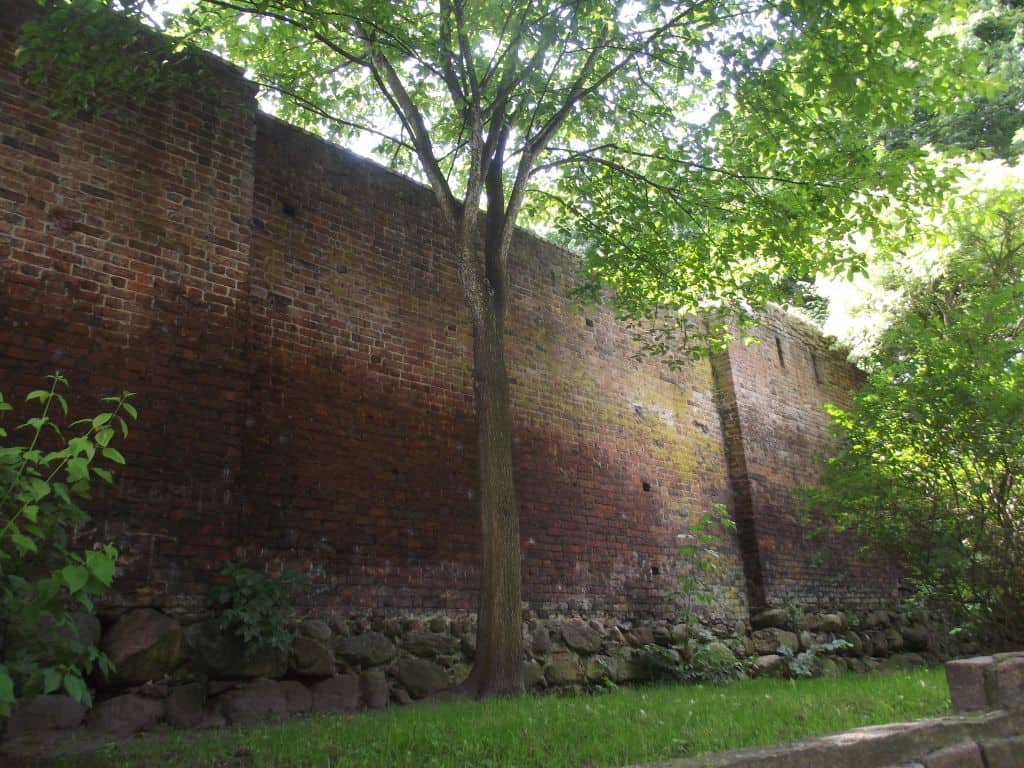
The defensive walls, and more specifically their elements can be seen in the vicinity of the Pomeranian Dukes’ Castle on Francesco Nullo Street at Jagiellońska Street and behind the Municipal Public Library on Grodzka Street. Those are the oldest elements of the former fortress on the Słupia River that have been saved from destruction. The walls were built in the years 1348–1385. Their total length was originally 2.4 km. Previously, their place was occupied by embankments and wooden structures with guard towers. The stockade separated the old fortified guard tower from the suburban villages. They also protected against attack. The walls were connected in such a way that, together with the former Słupia riverbed, they constituted a closed area that was easier to defend.
There were entrance gates to the city (two of them, the Mill Gate and the New Gate, are still preserved today), carefully watched by guards. Robust fortifications in the form of walls were built after 1325. Because in the existing wooden defensive structures, the gates were the weakest and most vulnerable places, their lower parts that existed in Słupsk were built first. From the north – the Holstein Gate, from the east – the Mill Gate, and from the west – the New Gate. In the second half of the 19th century, when the city started to grow rapidly, considerable stretches of the walls were pulled down, e.g. from the north and west. Already in 1834, the Powder Tower was dismantled, and in 1867 – the Holstein Gate. Modern outposts and embankments were leveled and replaced with greenstone and promenades.
THE USTKA COMMUNE
About the Commune
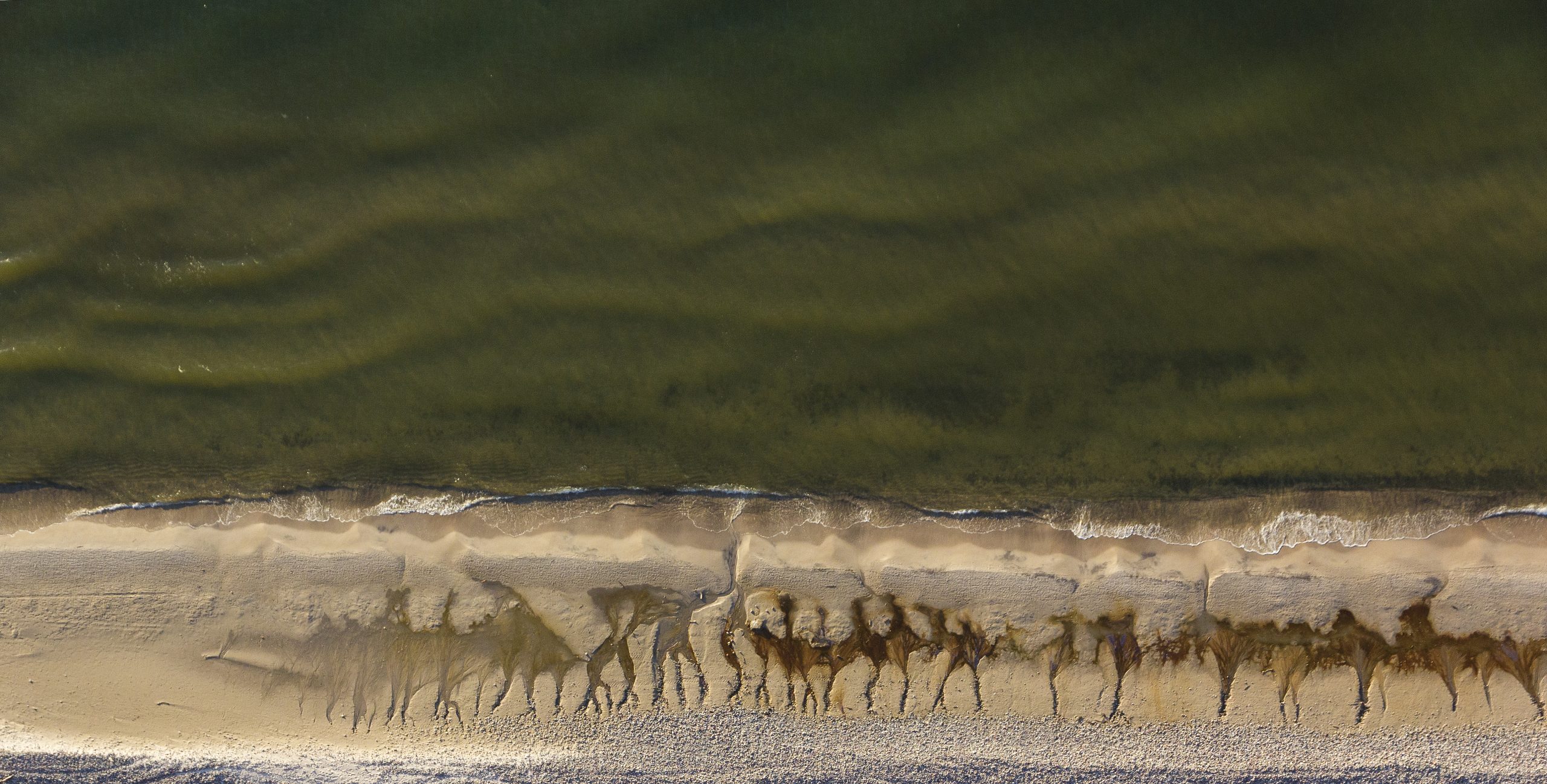
The commune is situated on the central coast of the Baltic Sea, between the mouths of the Słupia and Łupawa rivers to the sea. It is an area of outstanding landscape beauty and health values. From the eastern side it is adjacent to the World Biosphere Reserve – Słowiński National Park, and from the south with the Słupia Valley Landscape Park – the Monument of Animated and Inanimate Nature. Ustka Commune is composed of numerous coastal towns that surround the city of Ustka – a separate administrative unit located in the very heart of the commune. The eastern side was shaped as a cliff shore covered with beech, pine and mixed forests. On the western side there are wetlands as well as broad, sandy beaches owned by the Air Force Training Centre.
The most important holiday localities in the commune are: Rowy, Poddąbie, Dębina, Orzechowo and Przewłoka.
Rowy
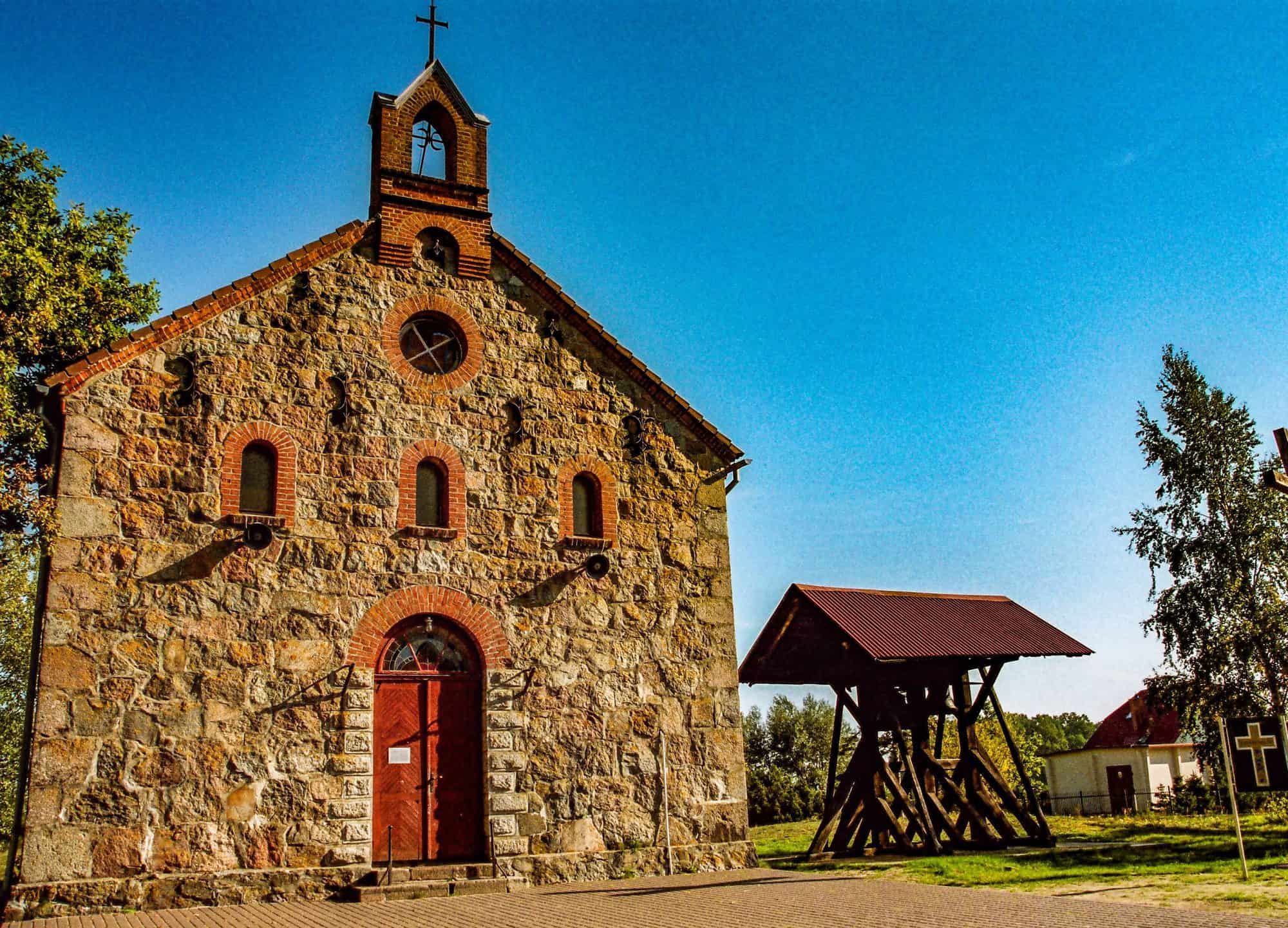
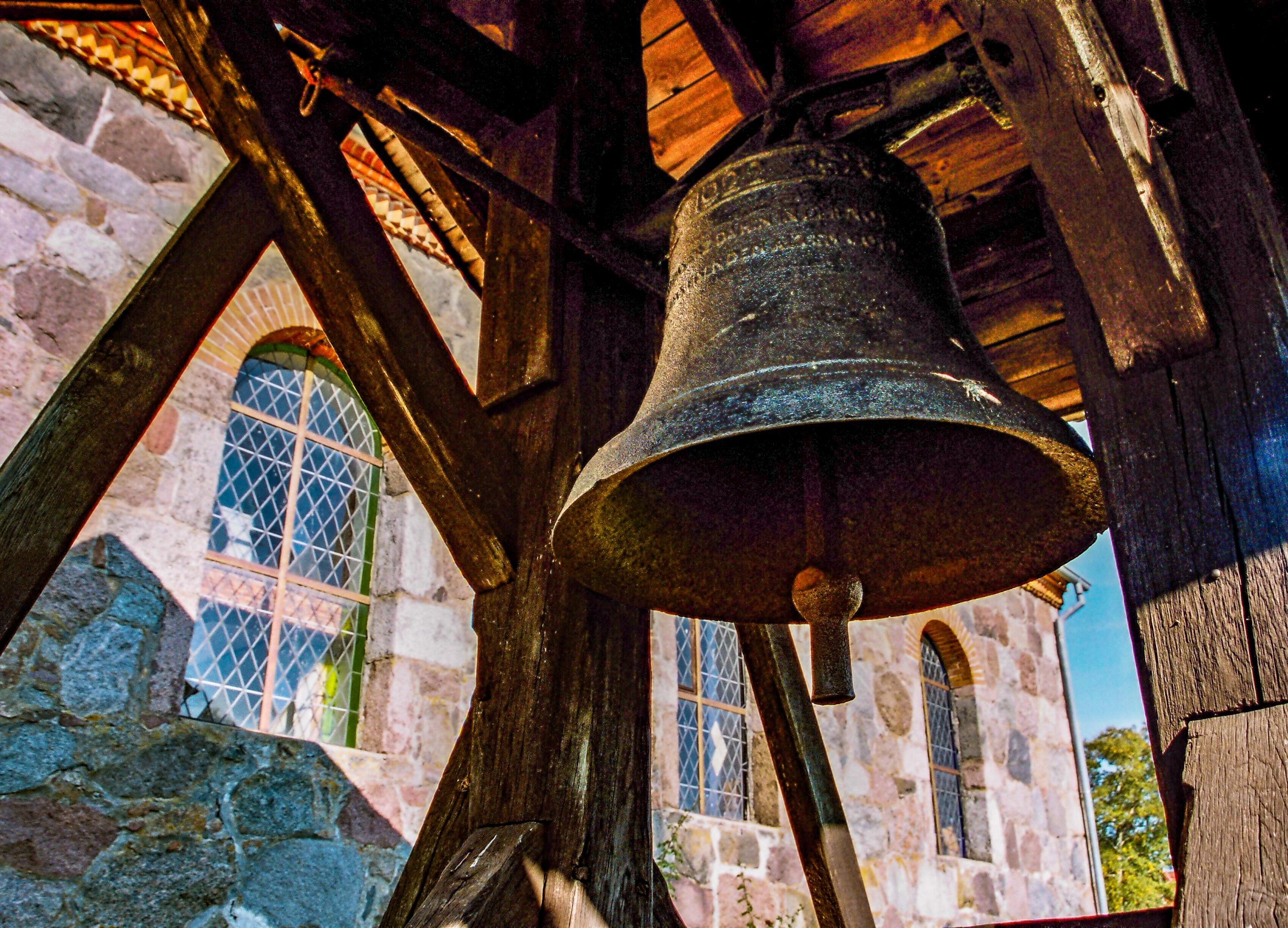
Rowy is the most popular swimming zone in the Ustka Commune.There is a well-prepared accommodation and catering base, a walking route and long beaches. In Rowy, the Łupawa River flows into the Baltic Sea, and along it we can meet fishermen at any time in the year. An indisputable advantage of the village is the vicinity of the Słowiński National Park – exactly here you can find the entrance to the western side of the Park, from where you can get all the way to Łeba. During the holiday season, Rowy pulsates with life which is due to the range of events offered there. Two major happenings that have been taking place for many years and have enjoyed unflagging popularity are the National Mascots’ Convention, which brings together giant plush toys which are an attraction especially for children and the National Review of Parade Brass Bands.. During this occasion, orchestras from various parts of Poland parade along the streets of Rowy together with dancing majorettes, guaranteeing spectators both visual and hearing experiences. The march is topped with a concert of orchestras in the Rowy concert amphitheater. Being in Rowy, it is worth taking a stroll not only along the waterfront promenade, but also along the trail of historical plaques entitled “Rowy Undiscovered”. The series of plaques tells about the first mentions of the village, the life of poor fishermen, and the fate of the first generation of fishermen who settled in Rowy after 1945, arriving from various parts of post-war Poland. A few dozen photographs from before the outbreak of World War II have been collected on eight double-sided plaques placed on the streets of Rowy. The oldest structure in Rowy is a 19th-century neo-Romanesque church built of cut stones. If you happen to travel near the church, it is worth finding an unusual black-colored stone linked with a legend that the devil himself has abandoned it there.
Rowy w niedalekiej przyszłości mają szansę uzyskać status uzdrowiska lub obszaru ochrony uzdrowiskowej. Dzięki znajdującym się w okolicy złożom borowiny oraz odpowiedniej wilgotności i nasłonecznieniu będzie tu można leczyć choroby układu oddechowego i krążenia oraz alergie skórne. In the nearest future, Rowy have the potential to become a spa or an area of health resort protection. Thanks to the nearby peloid deposits and adequate humidity and sunlight, it will be possible to treat respiratory and circulatory diseases as well as skin allergies here.
Watch Rowy on your camera online: http://ustka.ug.gov.pl/rowy.html
Poddąbie
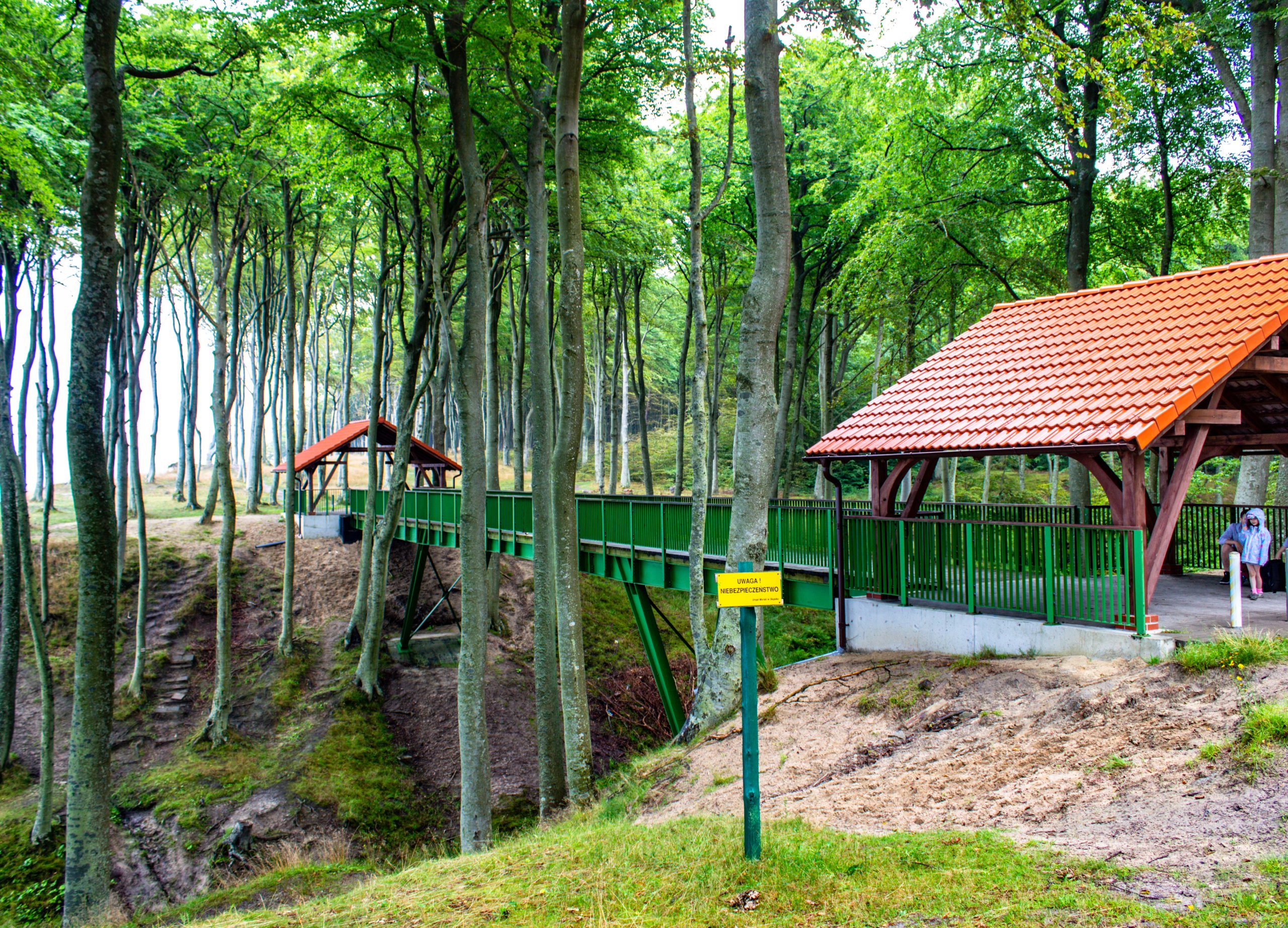
Next to Rowy, Poddąbie is the most important tourist resort in the Ustka Commune. A peaceful seaside town by day, it attracts tourists in the summer season with its charming, clean beach and picturesque cliffs. There are a number of resorts, holiday cottages, campsites and campgrounds.
On top of that, Poddąbie is an ideal place for a stopover and rest for bicyclers due to the bicycle station placed there. The bicycle station in Poddąbie is an innovative parking space for cyclists using the EuroVelo 10 route. There are not only bicycle stations or benches and tables intended to be a resting ground, but also amenities such as luggage lockers or a self-service bicycle repair station. A real innovation is the fitted solar panels for charging electric bikes or mobile phones, which allows the use of ecological renewable energy sources. The station in Poddąbie is the first of its type in the Pomeranian Voivodeship and the second in Poland. The town gained the name of the “Cycling Capital of Poland”, since it is the place of the Bicycle Orienteering Rally “The Trail of Rolled Tracks”.
Dębina
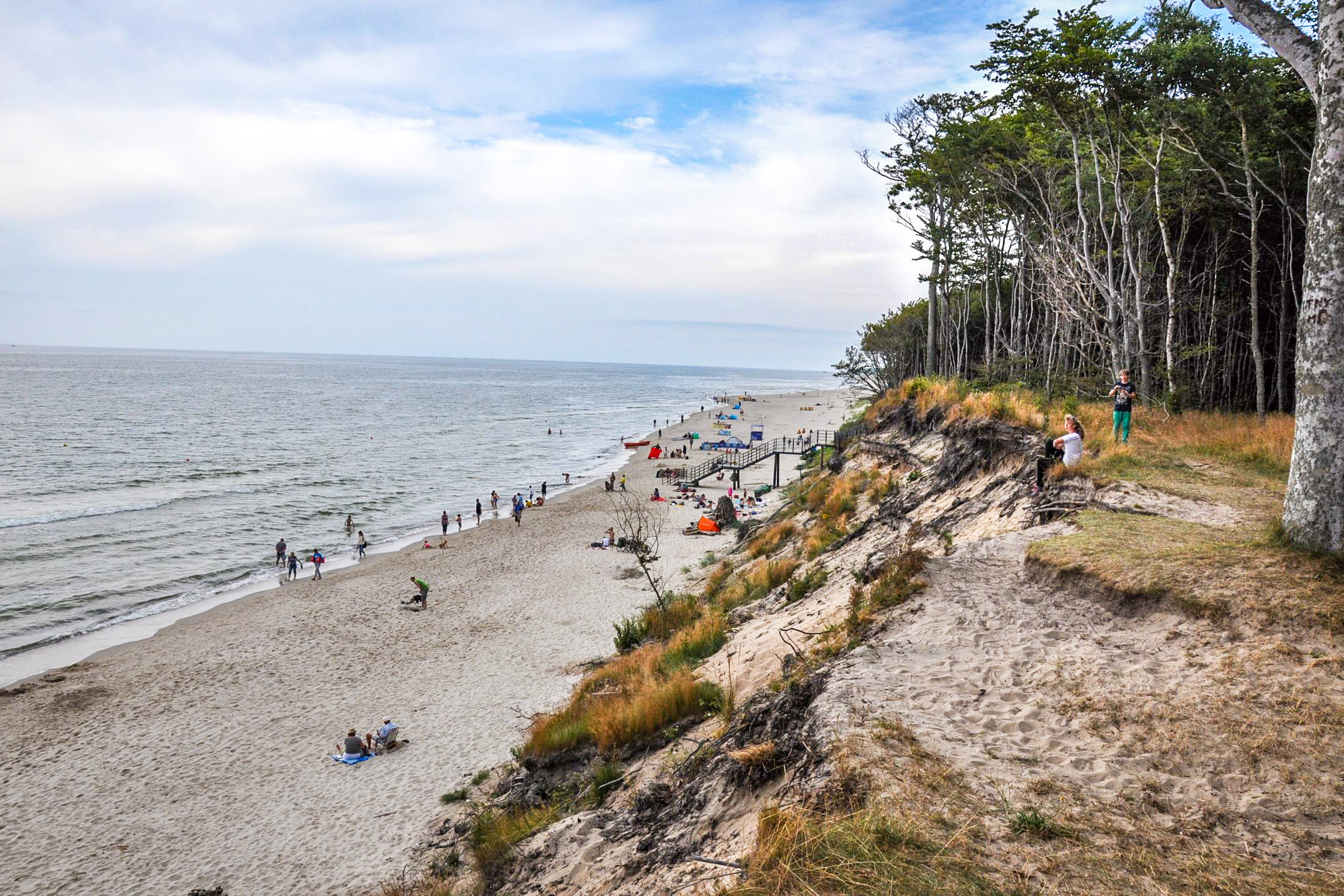
The tallest and most beautiful cliffs are located in Dębina. They are a real paradise for paragliders who, with a little bit of luck, can be admired from the broad beach. Thanks to the cliff coast and favorable winds, it turns out to be the ideal place for paragliding takeoff. The town can be proud of an interesting history – for over 30 years at the turn of the 19th and 20th centuries, the largest glass factory in Pomerania operated here. To this day, you can spot nuggets of bright green glass mass placed quite shallow underground. Two huge circular millstones located in the ground are the remains of the former steelworks.
Dębina, with its broad, climatic beaches, is beloved especially by tourists who enjoy quiet, peaceful and less crowded seaside towns.
Orzechowo
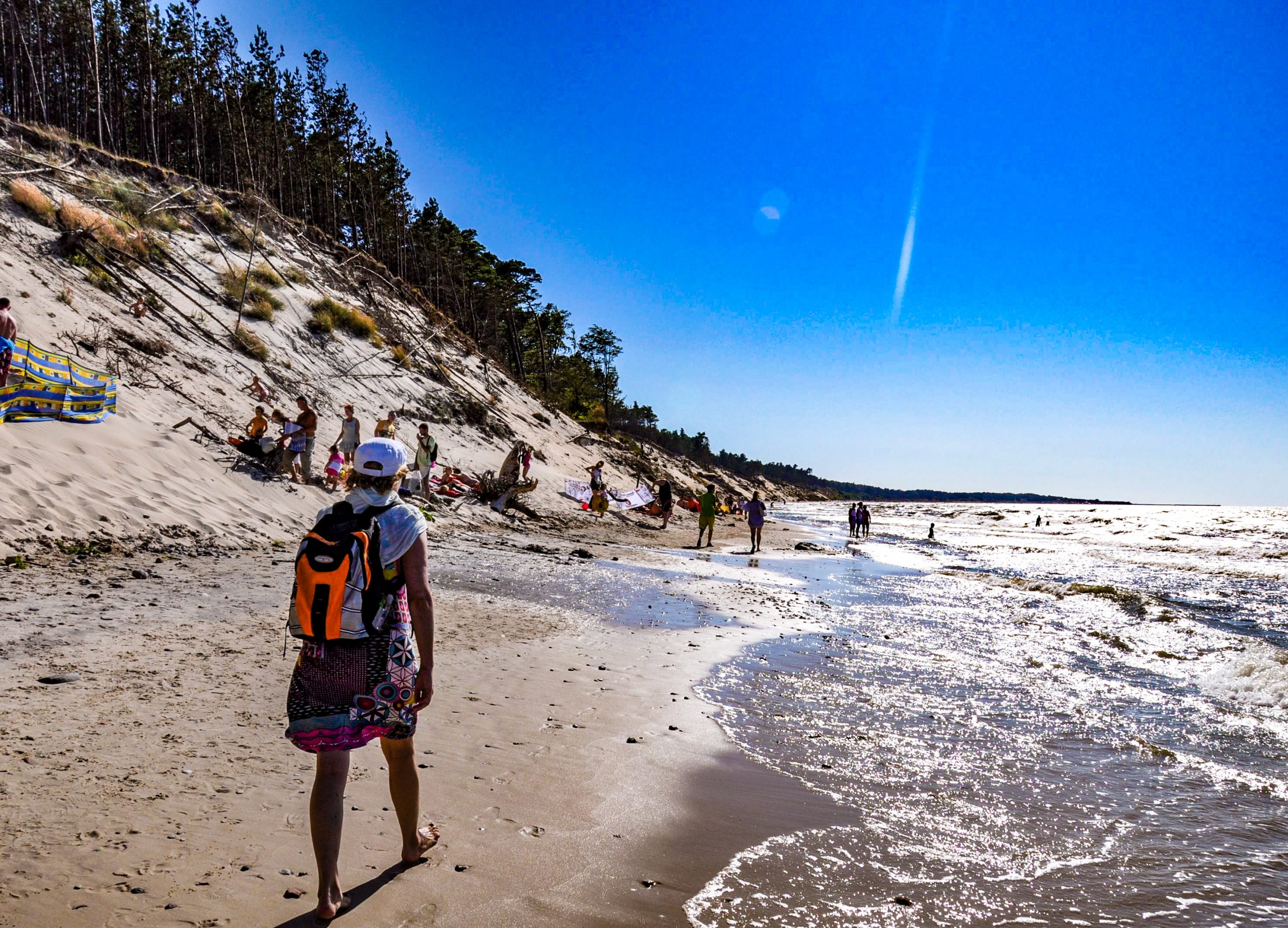
Orzechowo is a small holiday village located at the mouth of the Orzechówka River to the sea, 3 km east of Ustka. It was once a settlement of fishermen and sailors. It is a frequent goal for strollers from Ustka. The village can best be reached by walking along the beach or the red forest trail by the seaside. There is a mysterious tower in Orzechowo, often confused by tourists with a lighthouse. The tower is situated at the grounds of the „Leśnik” Training and Recreation Centre and although it is a fire watchtower in the summer, you can admire the coastal panorama from it for free. Orzechowo is a great starting point for those keen on active relaxation in the form of hiking, as there is an interesting Wildlife Educational Trail there known as “The Dune of Orzechowo”. The path starts in the “Leśnik” center (“Forester” center). The entire route is less than 3 km long and leads through the most striking elements of the seascape, such as dunes. A hike along this path is an ideal proposal for a family trip, and thanks to countless curiosities and educational plaques, it also plays an educational role – it introduces children to the fauna and flora of the seaside landscape. An additional attraction will certainly be the entrance to the almost 50-meter-high fire watchtower, which also fulfills the role of a viewing terrace, that offers a wonderful view of the Baltic Sea and the nearby forests.
Przewłoka
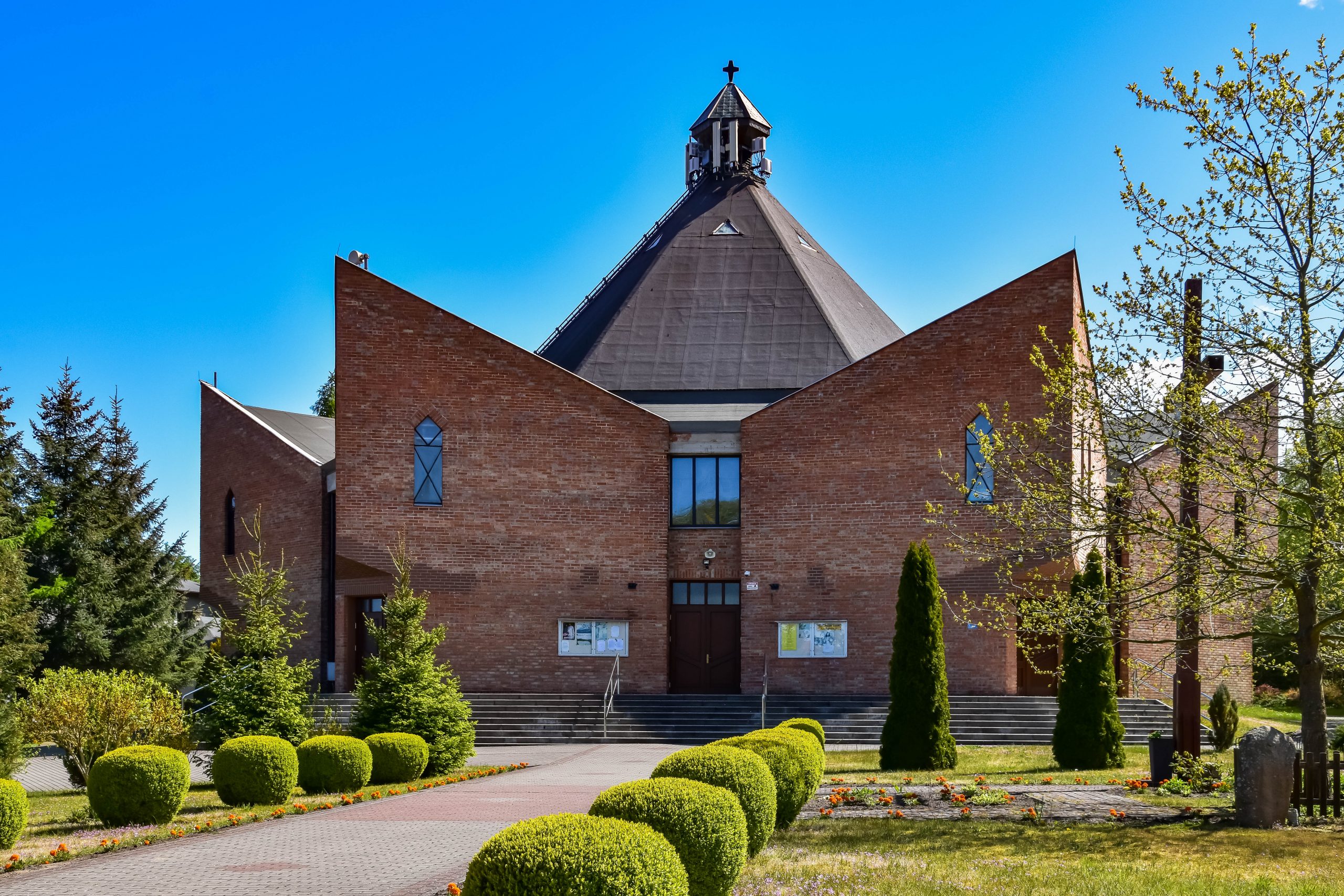
Przewłoka is located on the border with the city of Ustka, along the roof from Ustka to Rowy and on the international traffic biking R-10. Distance from the sea is about 1.5 km and it can be accessed by a pedestrian and bicycle path. In Przewłoka there is an architecturally interesting building built on the plan of a six-pointed star, the Star of the Sea Church. Situated near the border with the church there begins a 20 km long “Trail of Rolled Tracks”. Its name is not random – the trail follows the footsteps of the pre-war railway embankments. This is where the Bicycle Orienteering Rally “Trail of Rolled Tracks” launches consistently every year in July. There are many guesthouses and holiday centers in Przewłoka.
SŁOWIŃSKI NATIONAL PARK
Location
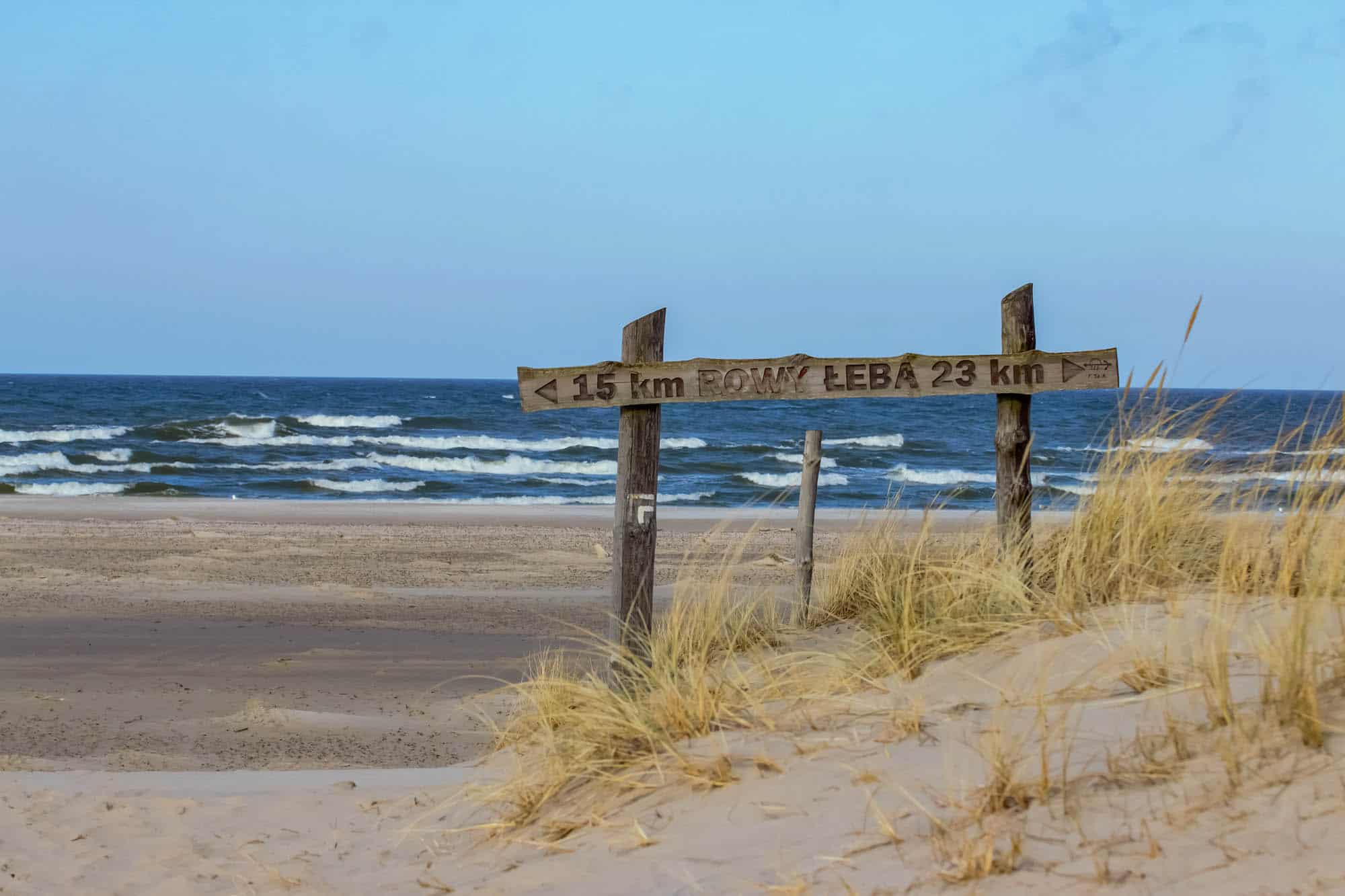
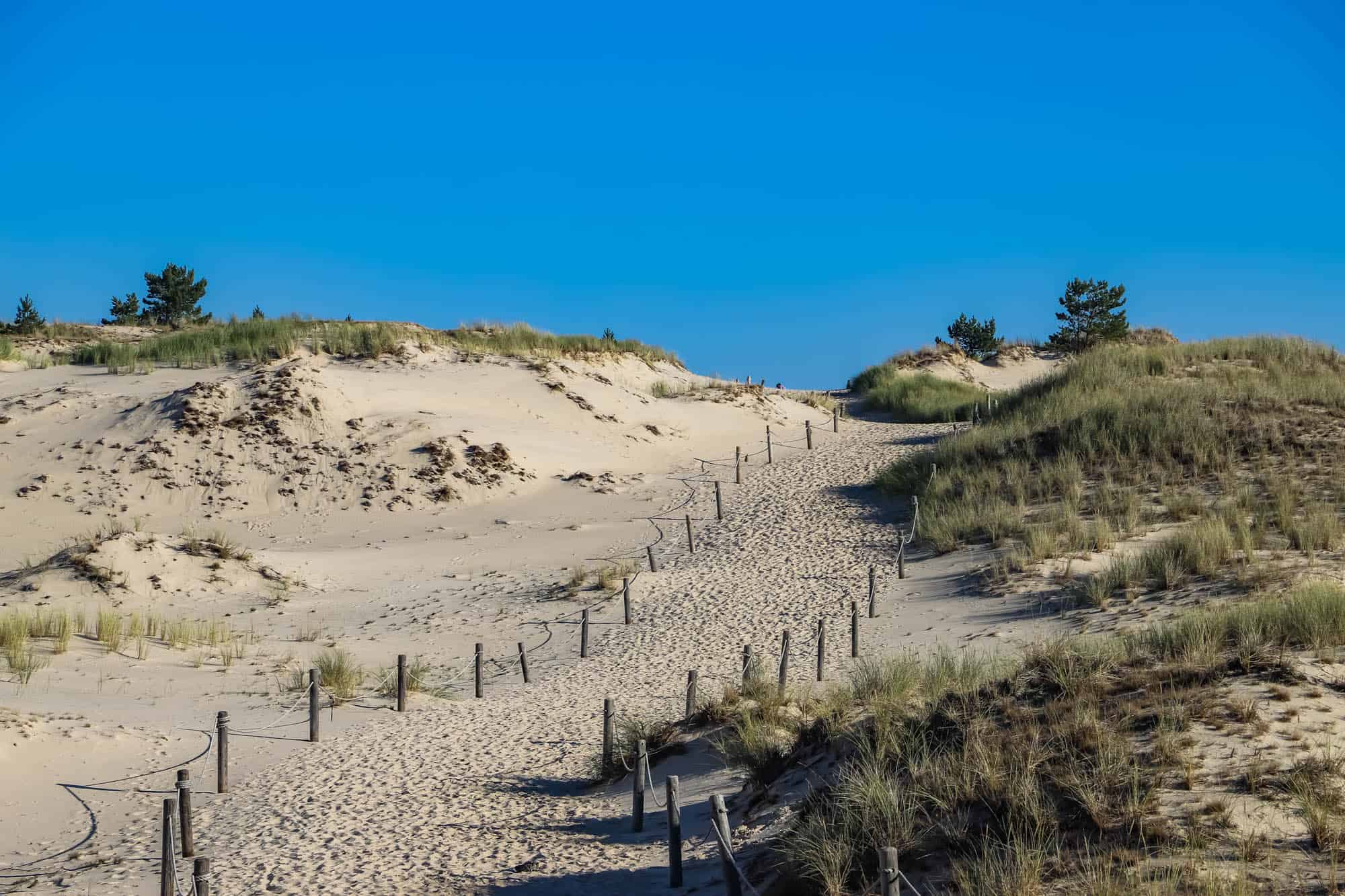
Słowiński National Park is located on the central coast, between Łeba and Rowy in the Gardneńsko-Łebska Lowland, in the Pomeranian Voivodeship. The northern border of the park is marked by the 32.5-km long Baltic Sea Coast. Works on creating the park were undertaken in 1946 at a conference in Łeba, which was attended by academics from Poznań and Gdańsk. It was established in 1967 on the area of 18,069 ha. The current estate area is 18,618 ha, of which 10,213 ha are water and 4,599 ha are forests. Strict protection covers 5,619 ha, including 2,529 ha of forests. The Słowiński National Park, recognized in 1977 by UNESCO as the World Biosphere Reserve with its shifting dunes, is a peculiarity at the European level.
In the past, the park used to be a sea bay. The topography of the park stems from the activity of the Scandinavian Ice Sheet and the later activity of the Baltic Sea. The ice sheet has left a chain of morainic hills that surround the park from the south and west. The highest moraine hill, Rowokół (115 m above sea level), provides an excellent viewing point over the entire park.
The Gardneńsko-Łebska Spit is built entirely of sand thrown inland onto the beach by the waves. The sand thrown onto the beach, dried by the sun and wind, is blown further inland. The result of this process will be the formation of moving dunes. The largest dune area is located on the Łebska Spit, and its surface is approx. 500 ha. The dunes come to a height of over 30 m above sea level and carried by the wind, they travel at a speed of 3-10 m per year. Wandering dunes along with 4 shallow seaside lakes are a peculiarity on a European scale. The largest of those are: Łebsko (7,140 ha, maximum depth 6.3 m), Gardno (area 2,468 ha, maximum depth 2.6 m) and Dołgie Wielkie (146 ha, maximum depth 2.9 m). Seven rivers flow through the park, the largest of which are Łeba and Łupawa.
Vegetation
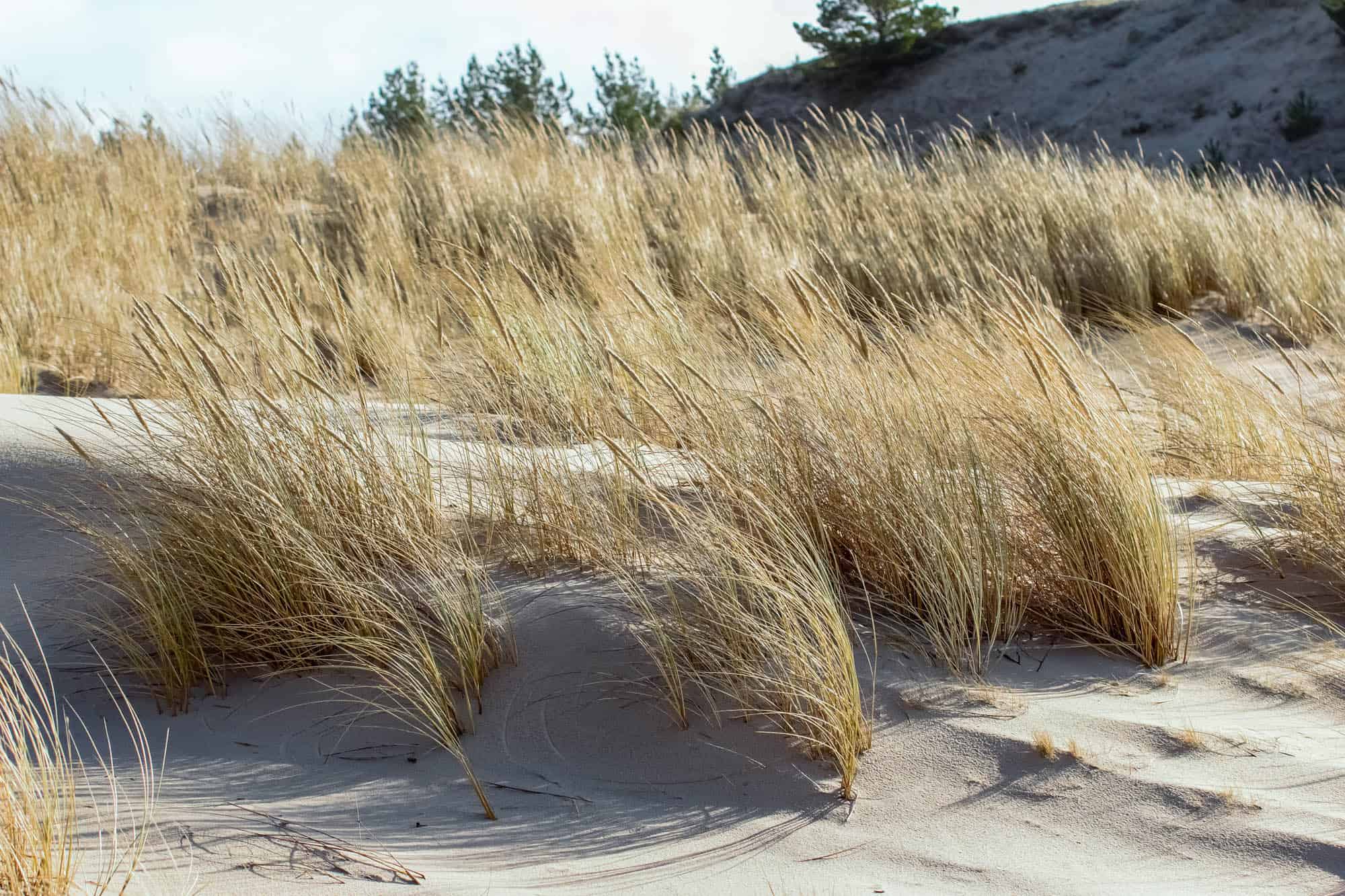
The most distinctive for the park is the zonal system of vegetation constituting a natural succession sequence. It runs parallel from the shoreline inland, and includes groups from pioneering and initial sand assemblages to coastal pine forests. The flora of vascular plants consists of approx. 850 species, 50 of which are under protection. One of the most interesting plant communities include large high and transitional peatbogs, as well as fens and meadow bogs. In total, 46 plant communities have been confirmed in the park.
Animals
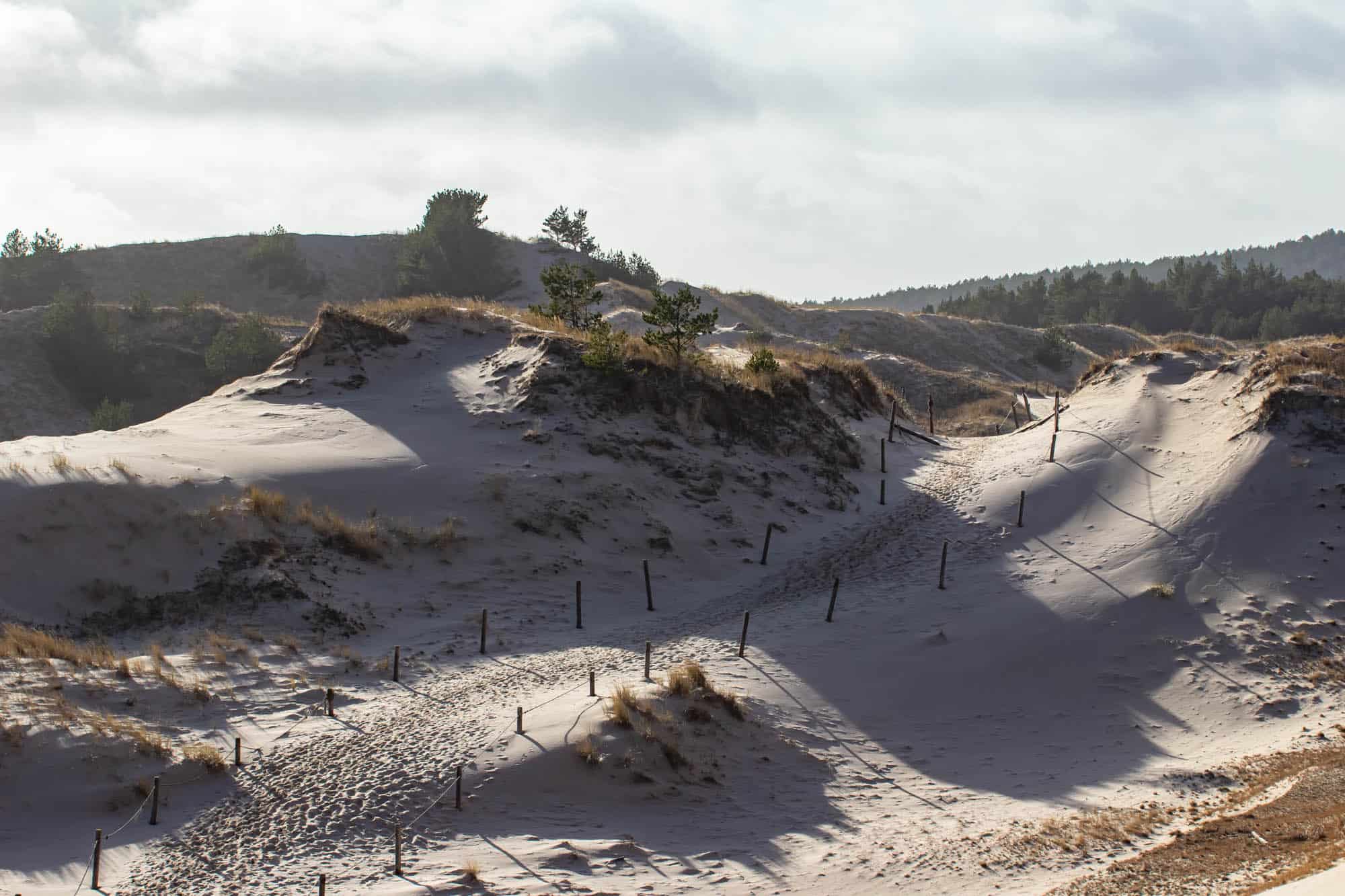
Birds constitute the predominating group of vertebrates in the park, with 257 species, including 150 breeding species. The abundance of avifauna is caused by the diversity of natural environments and the park’s location on the route of spring and autumn passages. The inaccessibility of the area means that almost all year round, birds find a place to nest or rest here during their passages. The most valuable bird species include: white-tailed eagle, lesser spotted eagle, golden eagle, eagle owl, raven, swans and numerous species of ducks. Among mammals there are countless deer, roe deer, wild boars, raccoon dogs and hares.
Origin of the Name
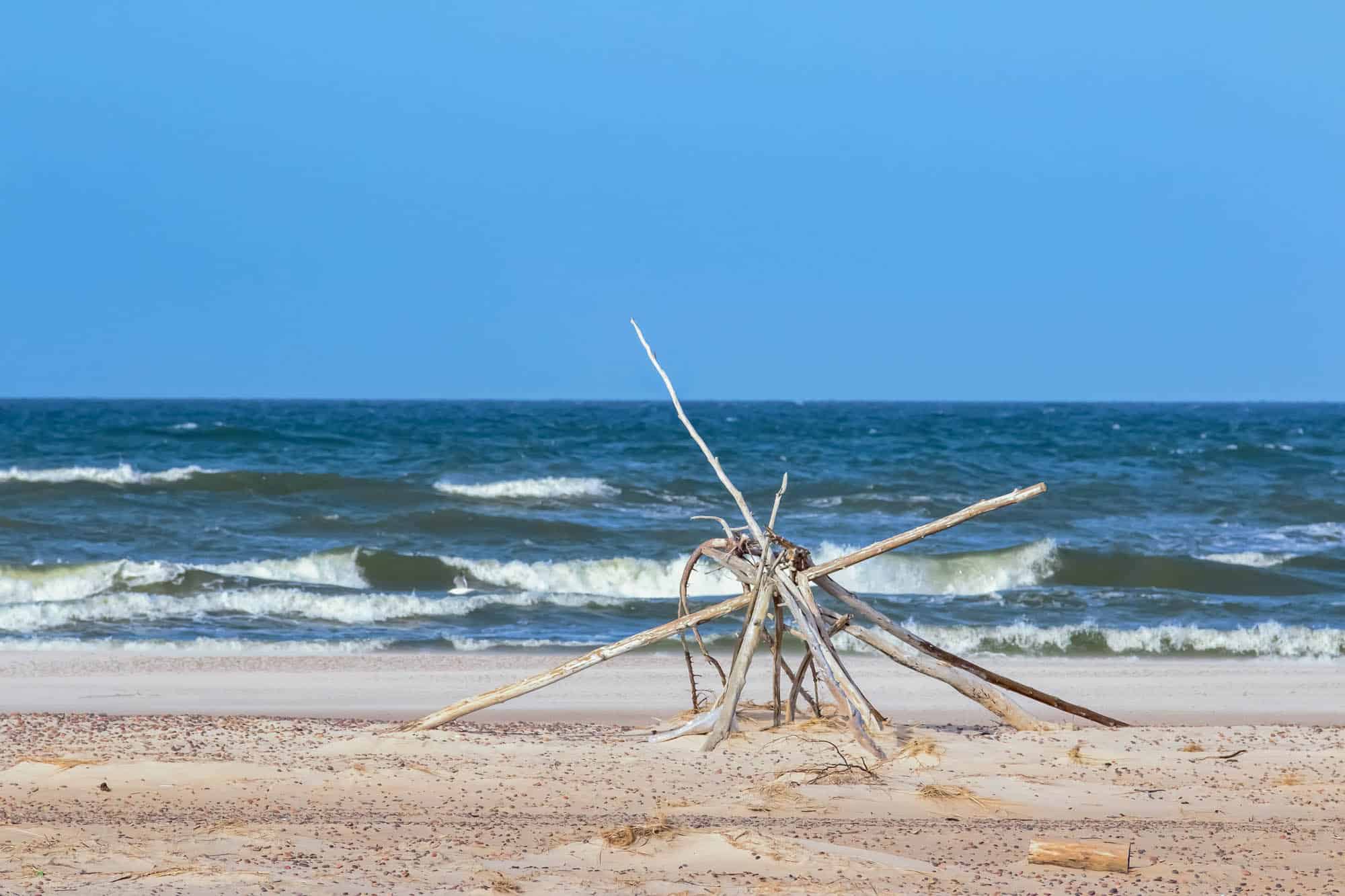
The park takes its name from a group of the Kashubian population – the Slovakians, who once lived in wetland, inaccessible, economically uninviting areas.There is an open-air museum in Kluki where the culture of this ethnic group is richly presented. There are 140 km of marked hiking routes in the park, which lead along the most striking natural and landscape areas. Furthermore, there are viewing platforms and lookout towers situated over the lakes, while along tourist routes one can see open-sided shelters, canopies, benches, etc. Motorized tourists can use parking lots. The park only allows heritage tourism. The park lakes are excluded from tourist traffic, with the exception of the Łeba – Kluki navigational route on Łebsko Lake, where tourists are transported by electric boats (current information at the Tourist Information Center in Ustka – 59 814 71 70, transport is carried out seasonally, in the last two years there was none).
DOLINA CHARLOTTY
Dolina Charlotty
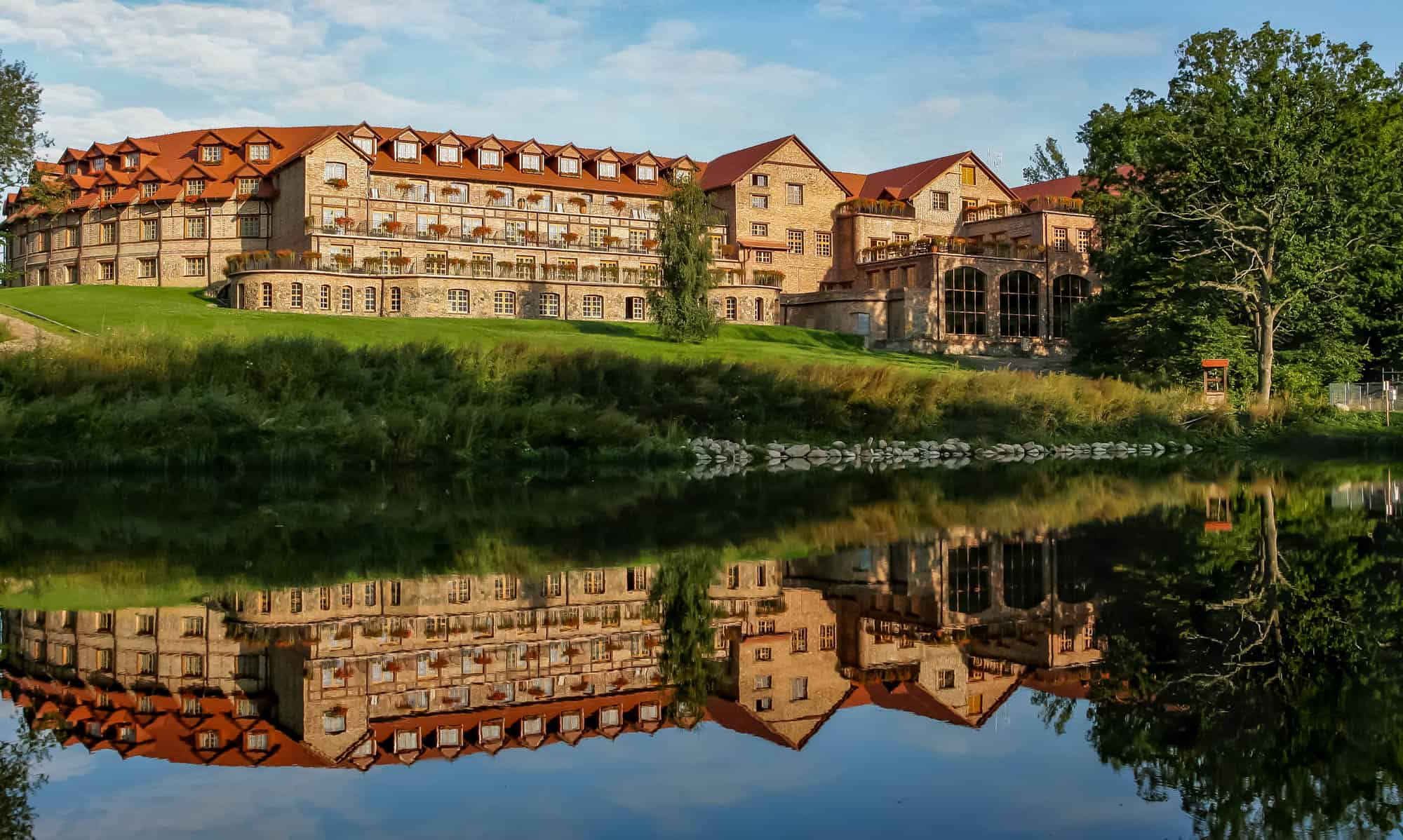
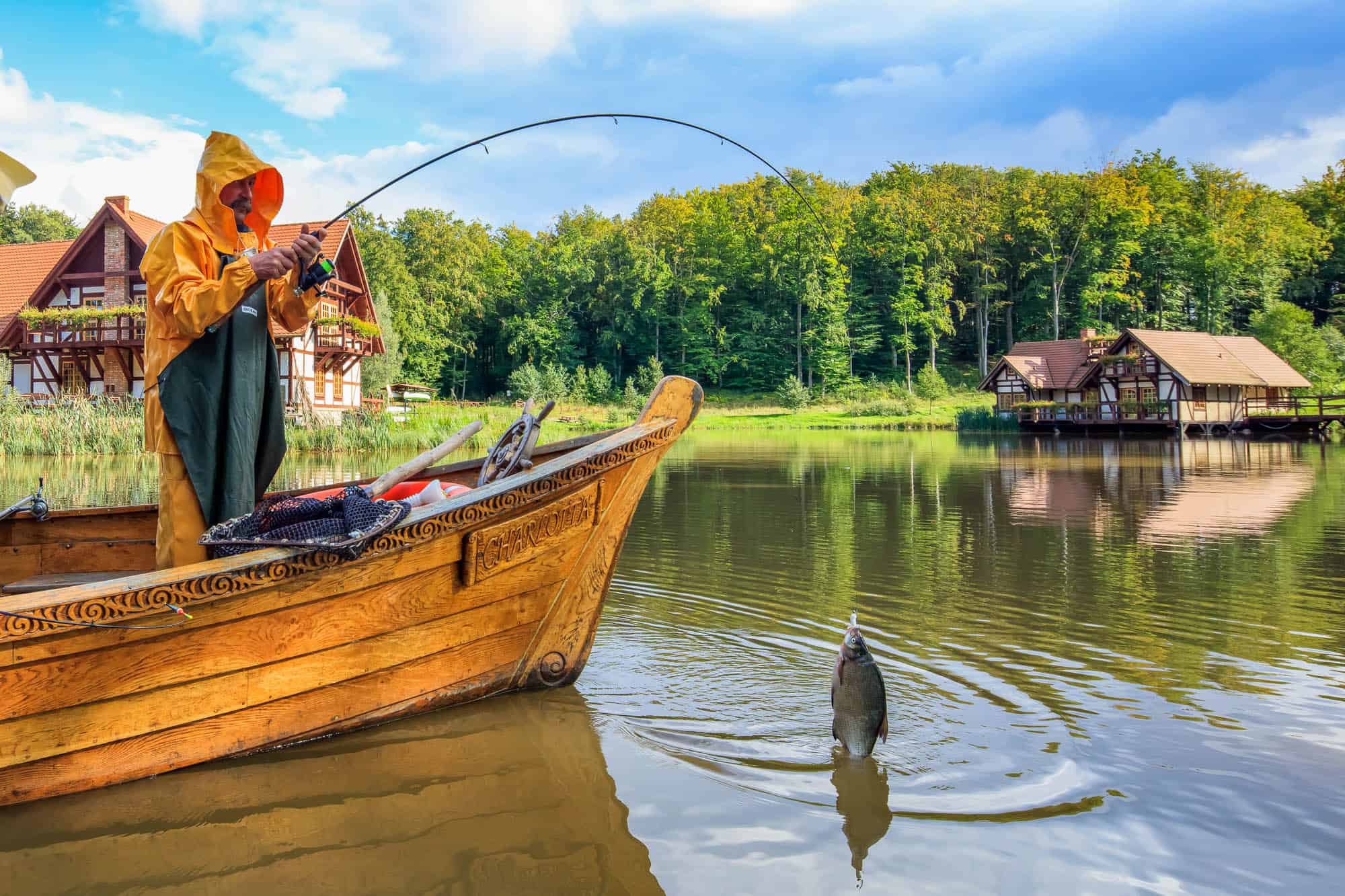
Charlotta Valley is a great recreational and leisure area located next to the village of Gałęzinowo on Lake Zamełowskie.When crossing through this area of Ustka and Słupsk, you cannot bypass this picturesque place. Tourists can expect numerous attractions. Enthusiasts of nature will certainly be interested in the Charlotta Zoo or the possibility of horseback riding. You can also enjoy fishing, water bikes and walking. As if this were not enough, Charlotta organizes the best cabarets during the holiday season! Ani Mru, Smile, Kabaret Młodych Panów, Łowcy. B, Kabaret Moralnego Niepokoju and many more have performed on this stage. Apart from a holiday humorous touch, in the summertime held here is the Rock Legends Festival.
Charlotta Charlotty also offers its visitors a relaxation side. The door to wellness & SPA stands open to everyone looking to relax their body and mind. There is also an option of using the pool or bowling alley. After seeing all the attractions and enjoying wellness services, you invite you to the Charlotta Gościniec Restaurant for an entertaining meal. That being said, Charlotta Valley is a place where you can spend an entire day with family and friends, or enjoy a solitary stroll around this picturesque site. All attractions are available in the summer from 1.05 to 30.09. Out of the tourist season, the Charlotta Zoo is available for visits on weekends. On top of that, in autumn and winter Charlotta Valley offers: jacuzzi, saunas, swimming pools and bowling.Charlotta Valley also offers its visitors a relaxation side. The door to wellness & SPA stands open to everyone looking to relax their body and mind. There is also an option of using the pool or bowling alley. After seeing all the attractions and enjoying wellness services, you invite you to the Charlotta Gościniec Restaurant for an entertaining meal. That being said, Charlotta Valley is a place where you can spend an entire day with family and friends, or enjoy a solitary stroll around this picturesque site. All attractions are available in the summer from 1.05 to 30.09. Out of the tourist season, the Charlotta Zoo is available for visits on weekends. On top of that, in autumn and winter Charlotta Valley offers: jacuzzi, saunas, swimming pools and bowling.
Charlotta Zoo

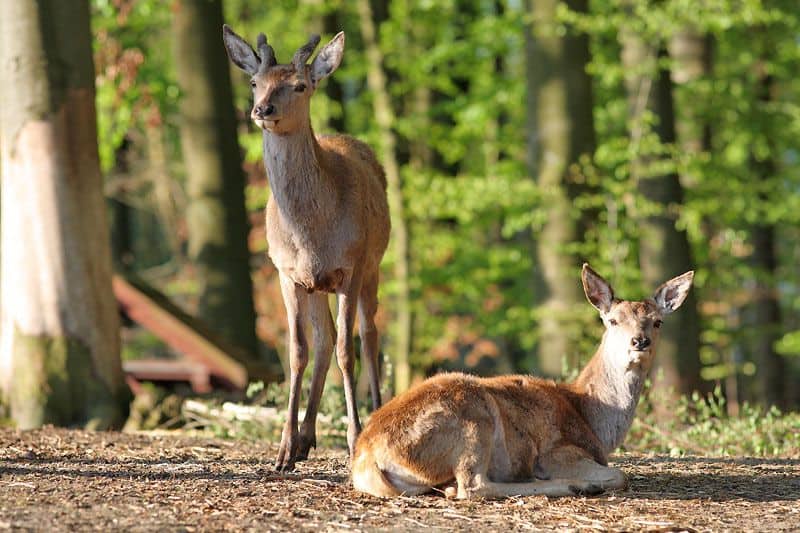
Charlotta Valley contains countless wonderful places where you can experience unforgettable moments. The Zoo in Charlotta Valley is inhabited by many species of fauna – both those well-known from Polish forests and such imported from overseas territories. Four-legged inhabitants were created conditions as close to natural experiences as possible. Here are also representatives of numerous species of the animal kingdom and heroes of adored fairy tales (The Land of Fairy Tales is an integral component of Charlotta Zoo), whose carved figures and fantastic houses are located in a unique setting. This small kingdom of fun and education is surrounded by wild nature and a beautiful landscape. At the waterfront of Charlotta Zoo, the Captain invites you to the Water Safari Zoo for a fantastic boat trip that takes participants on a journey around the world. During the cruise, you will visit thematic islands: Africa, South America and Australia, and the voyage is crowned with a mooring on the island of lemurs, inhabited by monkeys from Madagascar: King Julian and his merry gang.
In Charlotta Valley, at the guests’ disposal are two motor boats MS Ustka and MS Darłowo; each can take on board 26 passengers. In Charlotta Zoo there are 9 islands located in the Słupia backwaters, and they are inhabited by kangaroos, zebras, Japanese macaques, lemurs, tufted capuchins, ostriches, emus, black swans, white storks and snow cranes, and a dozen species of geese and ducks swimming on the water. On July 1, 2013, the largest seal sanctuary in Poland was opened here, and it is currently inhabited by 5 males of the Baltic grey seal (Halichoerus grypus). At the disposal of animals are 3 swimming pools with a total area of 1,500m² and a volume of almost 3 million liters of water. At the Charlotta Seal Sanctuary, thanks to special glass, it is possible to admire the seals under water! These exceptional animals, which move somewhat clumsily on land, are graceful under water. A so-called medical training is conducted with the seals, during which the instructors check on their state of health. During the shows, the seals demonstrate their charm, jump out on the shore, smile, raise their paws and are eager to say hello.
OPEN AIR MUSEUM IN KLUKI
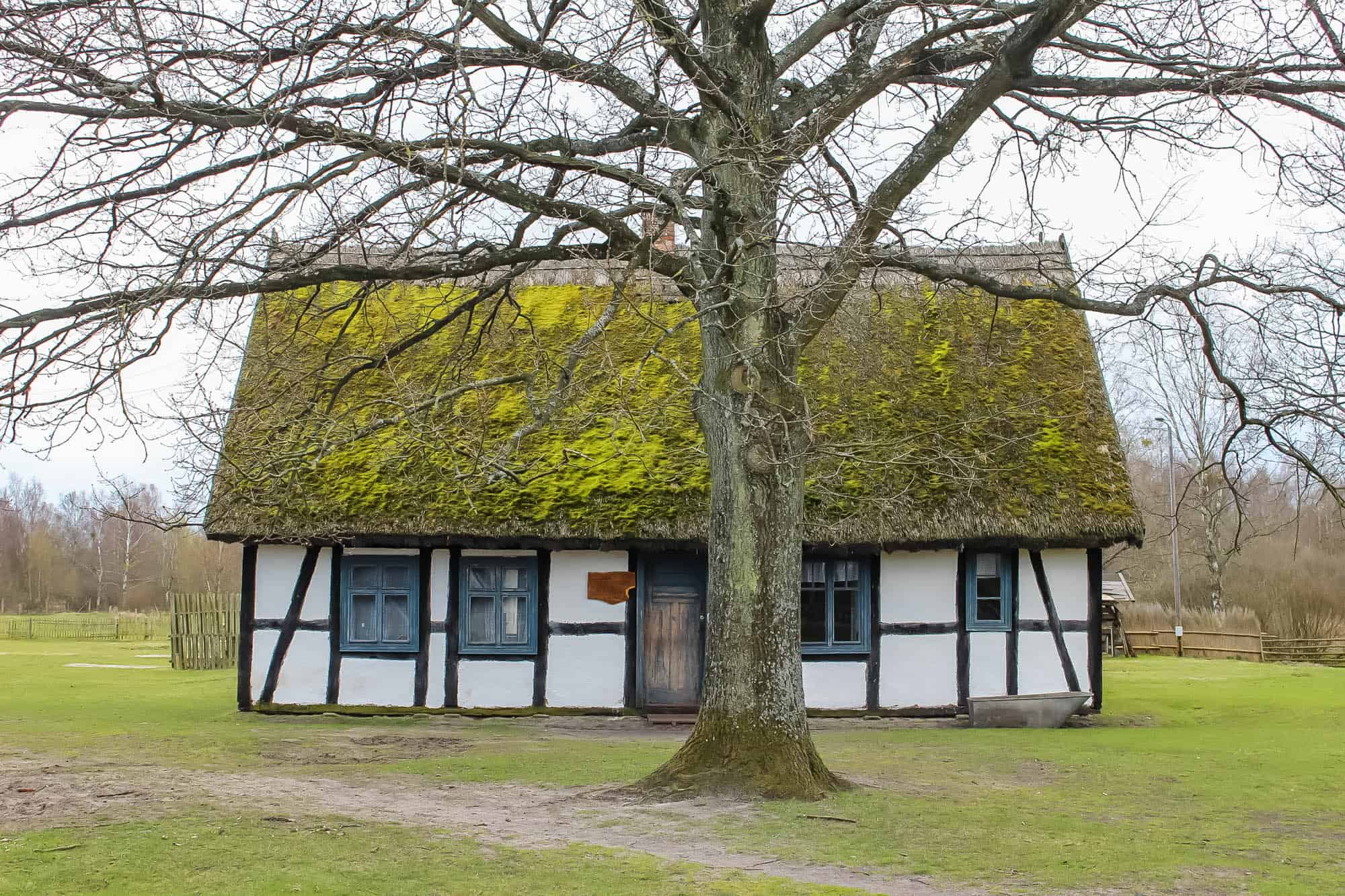
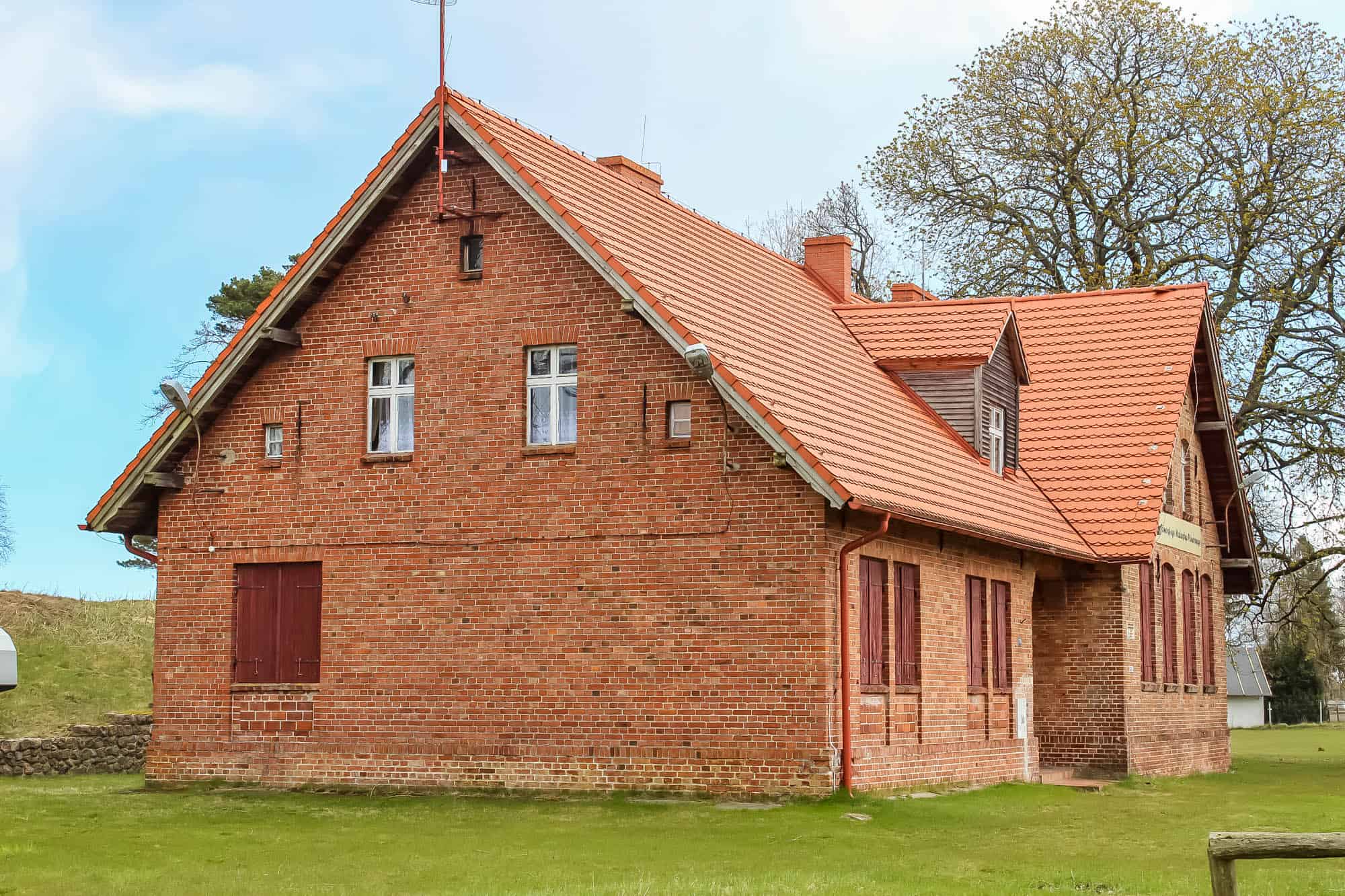
The will to preserve the disappearing Slovakian culture marked the opening of a museum in Kluki in 1963. The Museum of the Slovakian Village in Kluki is a division of the Museum of the Middle Pomerania in Słupsk and is located in the village of Kluki right by Lake Łebsko, about 40 km north of Słupsk.
The museum, which is a division of the Museum of the Middle Pomerania in Słupsk, lies in the area of Słowiński National Park, which is under strict protection, in the heart of the still operating village. It covers about 10 hectares, with 5 homesteads (including 3 preserved at the original location), 2 detached cottages, an inn, a warehouse and a fishing shelter, as well as 2 bread ovens. The museum also owns the grounds of the historic cemetery, established at the end of the 18th century, where early inhabitants of Kluki were buried, and the brick structure of the former school, where the Gallery of Pomeranian Outdoor Painting is located.
Timber-framed cottages originating from different times and their furnishings indicate the changes that have occurred in the Slovakian countryside over the centuries. Numerous open-air events add to the particular atmosphere of the vibrant village. The shows taking place during outdoor events bring visitors closer to the culture and lifestyle of Slovakians. The “Black Wedding” (May 1-3) marks the opening of the season; it is an event referring to the tradition of joint digging of peat, which was used primarily as fuel after it was dried. On June 1, the open-air museum warmly greets children; it is exactly for them that the festival with various shows, games and competitions is held on the occasion of Children’s Day. July and August are the time of events “A Sunday with the Kliks” and “In the Slovakian Homestead”. A farewell to summer at the open air museum always takes place on the third Sunday of September and is an opportunity to taste local culinary specialties: bread baked according to an old Slovenian recipe, smoked eel, Klitundplome soup (plum soup on smoked goose with dumplings), fish soup, fried blueberries with pears, yeast wafers and many others. An additional attraction, especially for the younger tourists, are animals bred by one of the open-air museum farms: horses, sheep, ram and goat.
POMERANIAN FOLK CULTURE MUSEUM IN SWOŁOWO
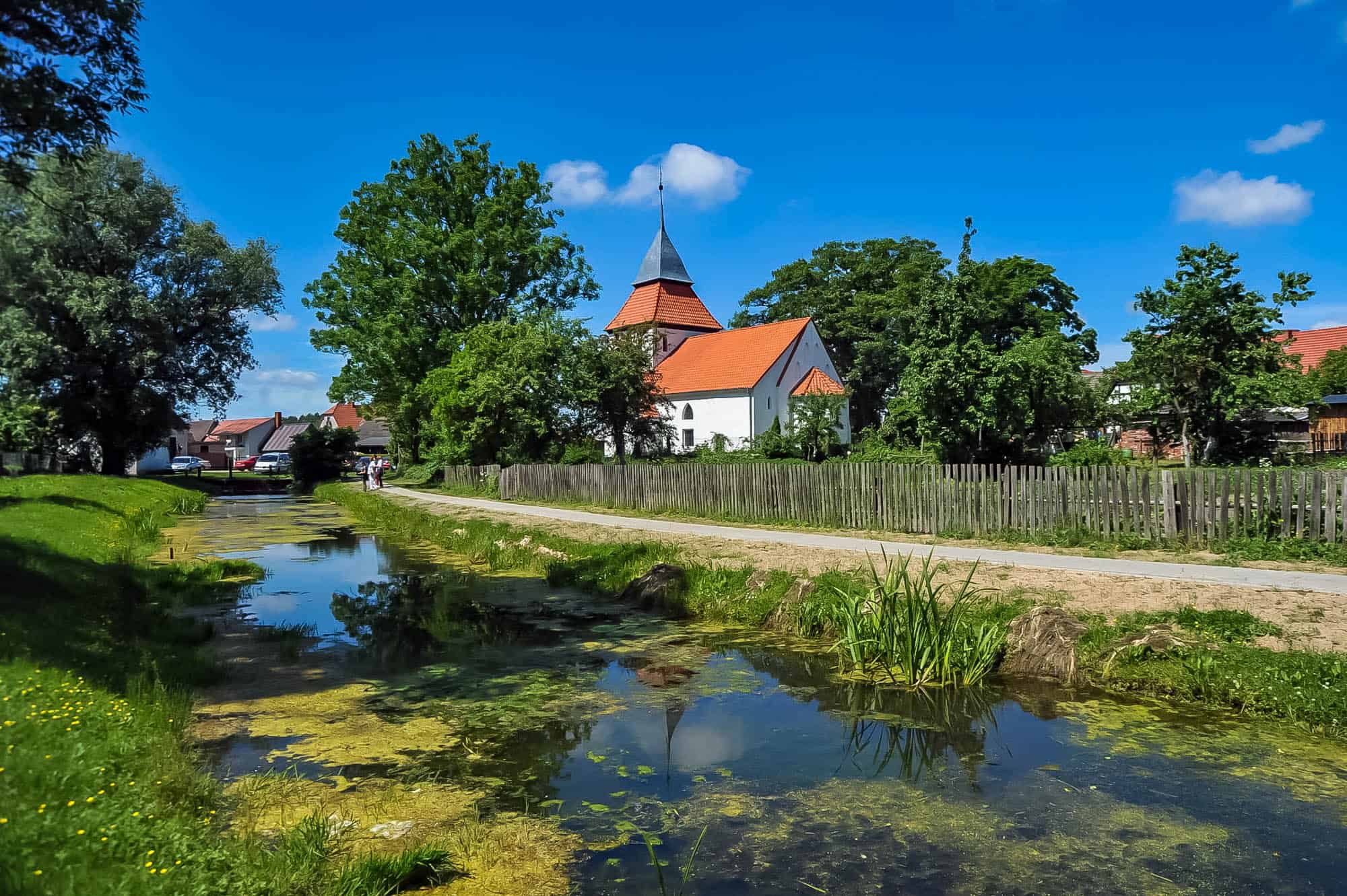
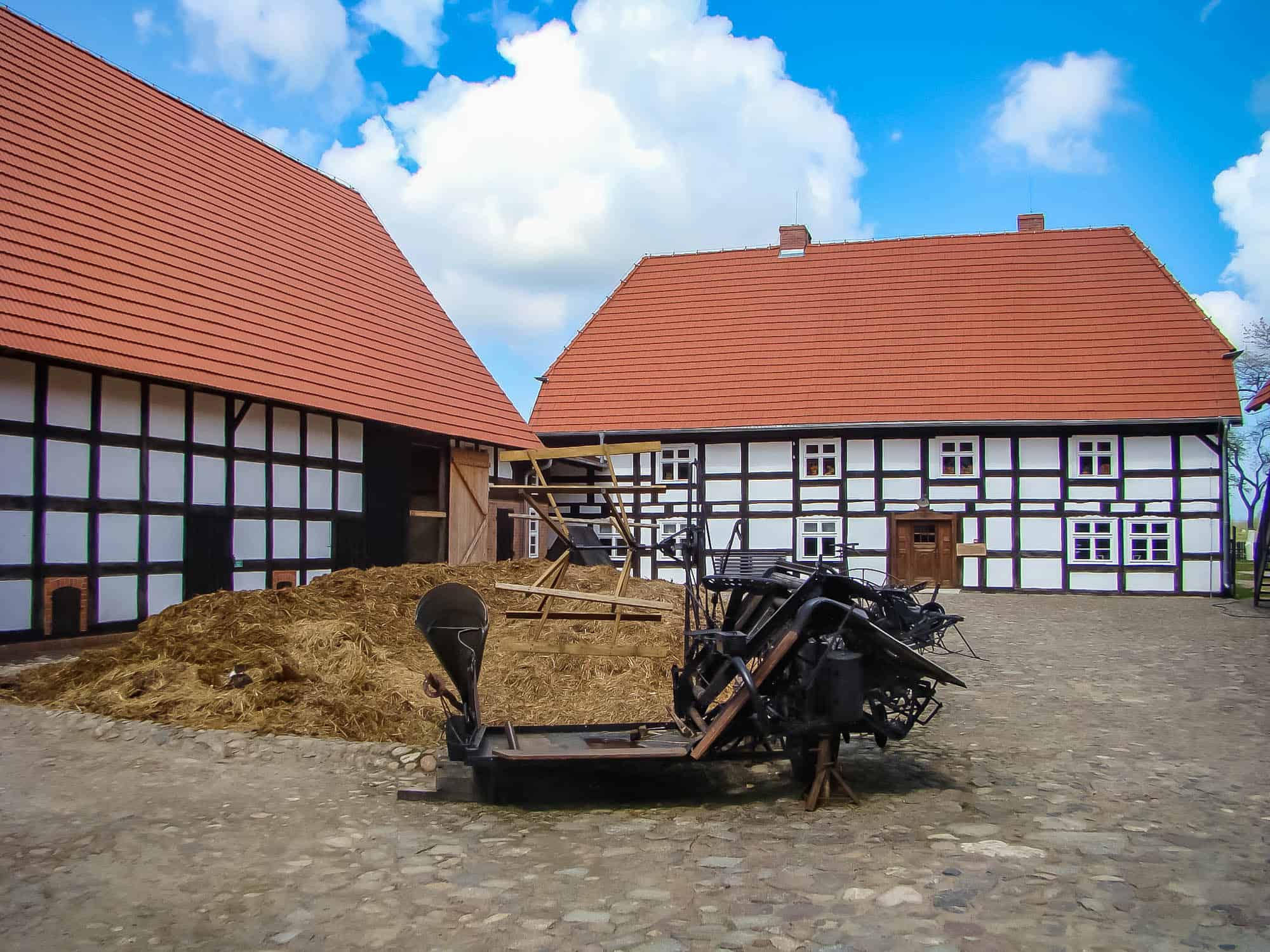
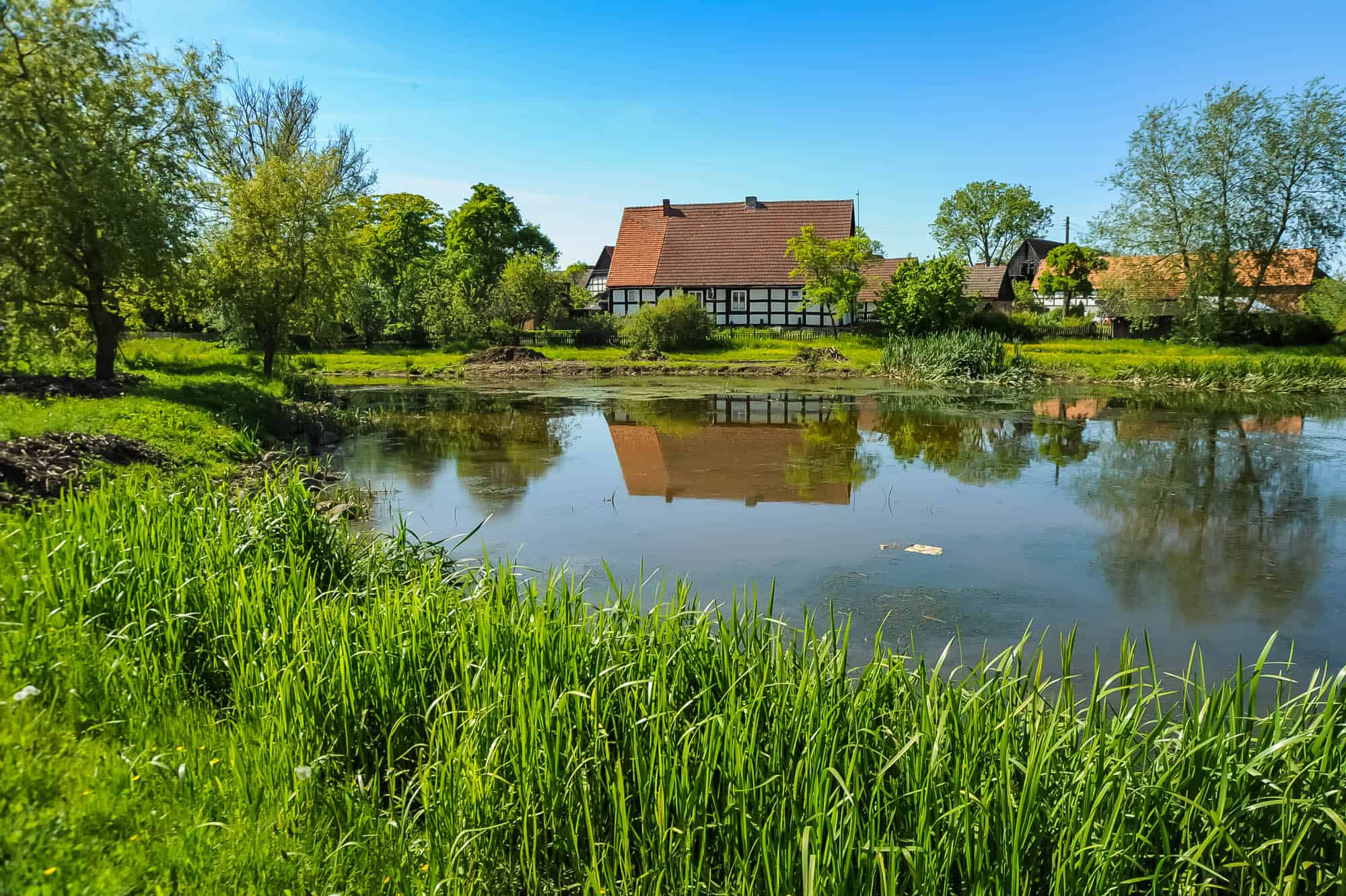
The Pomeranian Folk Culture Museum in Swołowo is currently one of the most modern open-air museums in Poland.
The museum offers ample opportunities for sightseeing of 15 meticulously modernized antique country buildings erected in a frame construction, located in the very center of a “living” village. The chequer-board pattern of buildings has become a permanent part of the rural landscape, which is why Swołowo is called the capital of the “Checkered-House Land”. The village is situated 14 km west of Słupsk. Thanks to its location on the sidelines of major transportation routes, Swołowo has retained its spatial arrangement dating back to the Middle Ages. It is an oval village, or a flattened circle – one of the few in Pomerania. At the center of the village there is a spindle-shaped square typical for this type of community, with a church and a pond in its central part. The square is surrounded by two interconnecting roads, with homesteads placed by them, and beyond stretches a strip-farm arrangement. The unique architectural and spatial qualities of the village have enabled Swołowo to receive the title of the European Village of Cultural Heritage.
For several years, ethnographers and museologists have been restoring the splendor of this extraordinary village. To date, 15 historic buildings have been saved. All have become part of the Pomeranian Folk Culture Museum. The reconstructed and renovated 19th-century monuments fulfill an exhibition and cultural function. Two barns and a cowshed were furnished with multimedia ethnographic exhibitions depicting the history and rural culture of Pomerania, including: Pomeranian carpentry, woodwork, traditions and legends, and weaving. Exhibitions affect the imagination which is stimulated by many senses – with the help of visual, auditory, scent and tactile stimuli, visitors learn about the space and mood of individual exhibitions.
The museum runs a rich educational program for children and youth, including lessons and workshops connected thematically with rituals and everyday life in a former Pomeranian village. Visitors may take part in threshing cereals, chopping straw, grooming of farm animals (horses, sheep, geese, chickens and ducks are bred in the museum), cooking on an old tiled kitchen, and brewing beer according to the age-old recipe of Swołowo. There are demonstrations of baking bread and the work of a smith.
The open-air museum hosts cyclical events for tourists from all over Poland. The most popular include: “Asparagus Festival” (June), “Children’s Homestead” or educational and artistic meetings for children (every Sunday in July), “Blacksmith Forum’s Open Air” organized jointly with the Blacksmith Forum Association (August), Pomeranian Herb Festival (15 August), “Indian Summer “, during which a contest for the best home liqueur is held (end of August/beginning of September) and a culinary feast – an event known as “Goose for Saint Martin’s “(November 11), attracting goose gourmets from all over the country. The museum is open all year round. The unique architectural and spatial qualities of the village have enabled Swołowo to receive the title of the European Village of Cultural Heritage.
KĘPICE AND THE SURROUNDING AREA
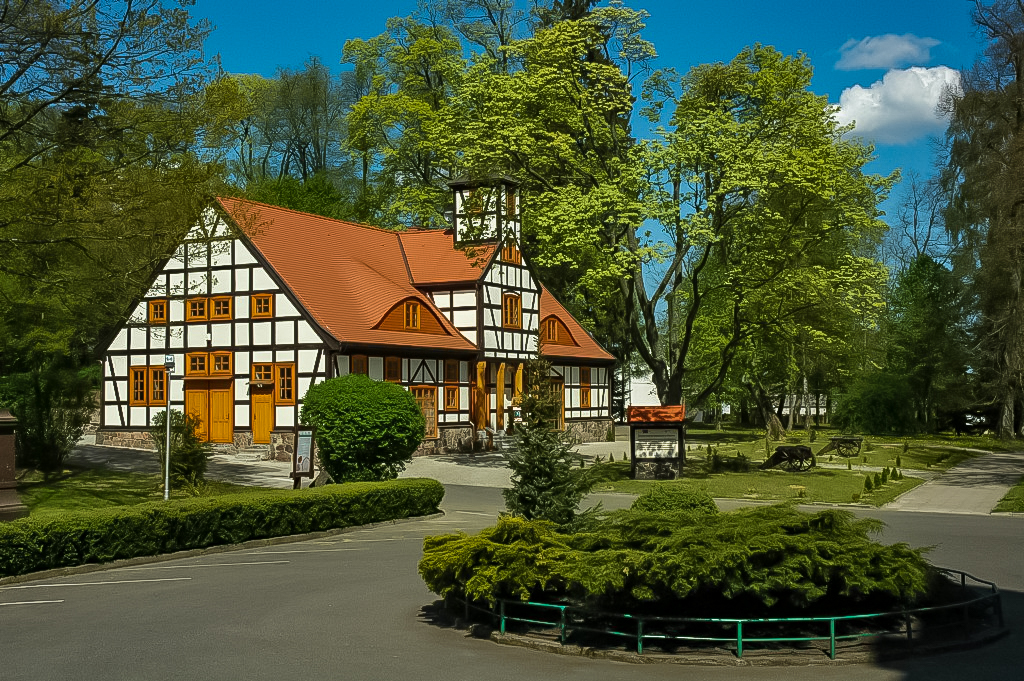
Kępice and the surrounding area is one of the most forested regions in the country, which holds a great variety of rare birds, game and undergrowth! There are accommodation bases that await holidaymakers: agritourism lodgings and guesthouses, even natural heritage monuments are worth a closer look. The rivers are home to salmon fish – brown trout and sea trout.
Vast forests are a nesting place for rare bird species, such as: white-tailed eagle, lesser spotted eagle and greater spotted eagle, red kite, honey buzzard, eagle owl and black stork. Around the lakes you can admire ospreys, whooper swans and numerous species of wetland birds. In lakes, there are newts and crayfish, and the swamps are a nest site of a very rare pond turtle.
Numerous hordes of deer, packs of wild boars and medal-worthy stags are a magnet attracting hunters from Poland and abroad. In the forests of the Kępice Commune there are fallow deer, foxes, badgers, raccoon dogs, martens, polecats and hares. In the Wieprz River, you can also fish perch, gudgeon, fence, bleak, burbot, brook lamprey, river lamprey and grayling.
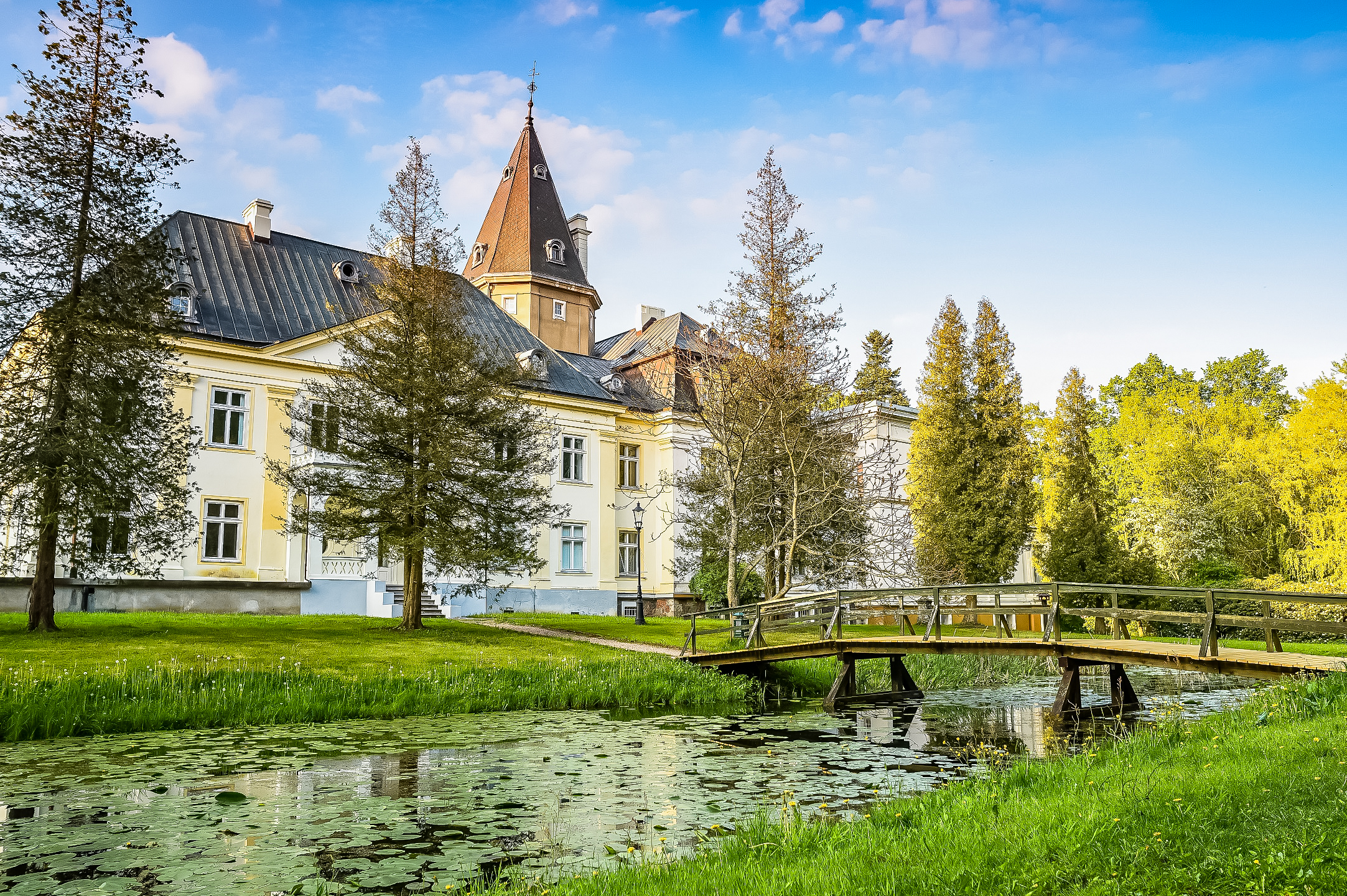
Warcino Palace
The Warcino Palace, situated near Kępice, is one of the most highly valued and best-preserved monuments in the region from the 17th century. In the past, it was the favorite residence of the German Chancellor Otto von Bismarck. To this day, mementoes of him and his family, including the famous fireplace room, have been preserved in the palace. It was built on a plan of four rectangles with a tower, and is surrounded by a beautiful 18th-century park with many well-kept specimens of old trees. It is worth visiting the original fireplace room (formerly Bismarck’s office), hunting room and white room. There is a Regional Education Center in the nearby coach house.
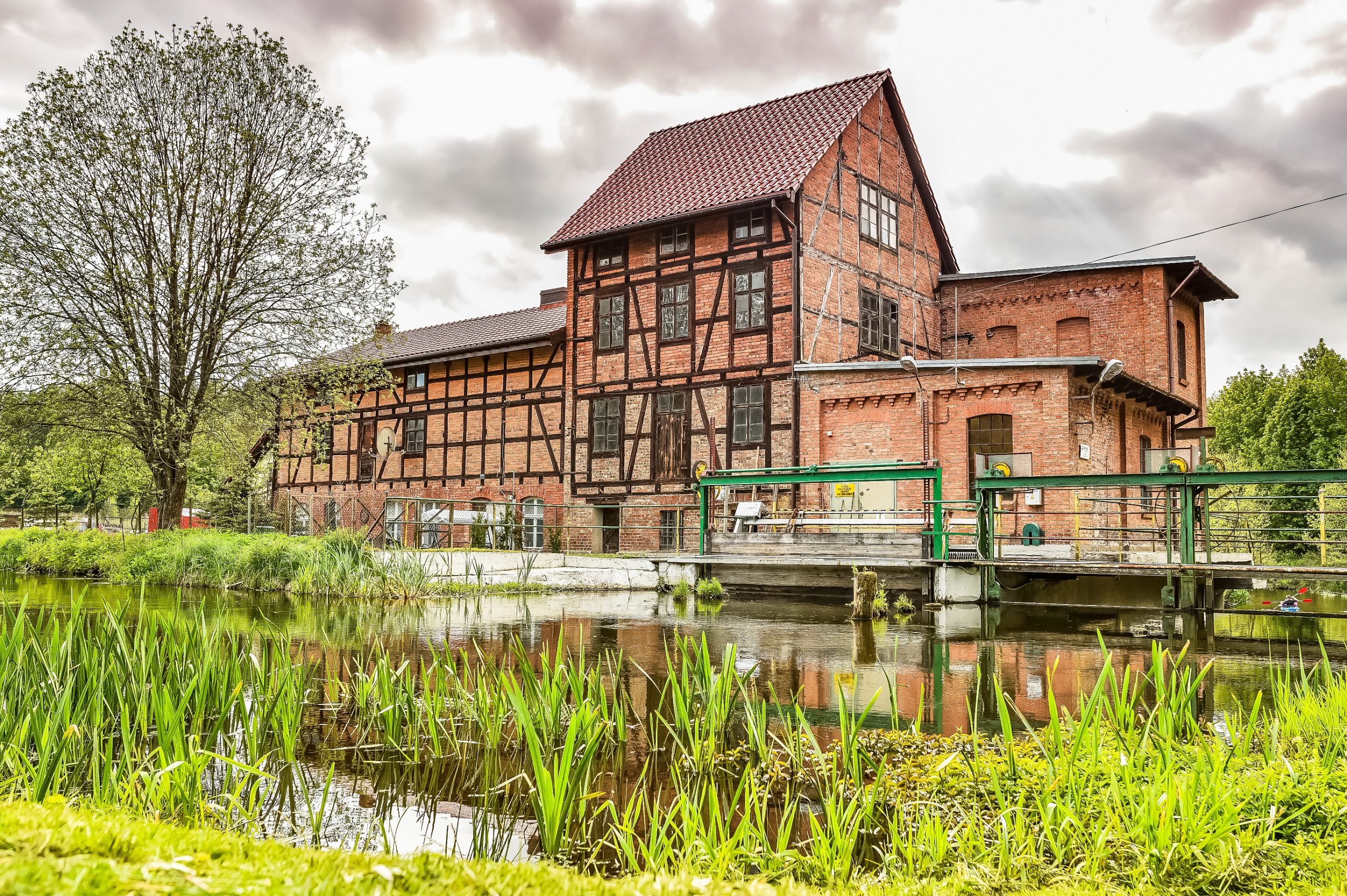
Hammermühle Papermill
In the Kępice commune, kept are also monuments of industrial architecture, including hydroelectric power stations, railroads and industrial plants The buildings of the former Hammermühle Papermill tower over the slope above the Wieprz River. The tower was established by Bismarck, who decided to use the forests for production of paper. The factory generated substantial income and quickly established itself as one of the best in Prussia. It also gave rise to the development of a small settlement and made a contribution towards the former Hammermühle (named after the papermill), or Businko after the war, and in 1947 Kępice became a city. During World War II, counterfeit dollars and pounds were printed here for German spies. There is currently a tannery here – KEGAR, which produces high-quality leather for the production of, among others branded handbags.
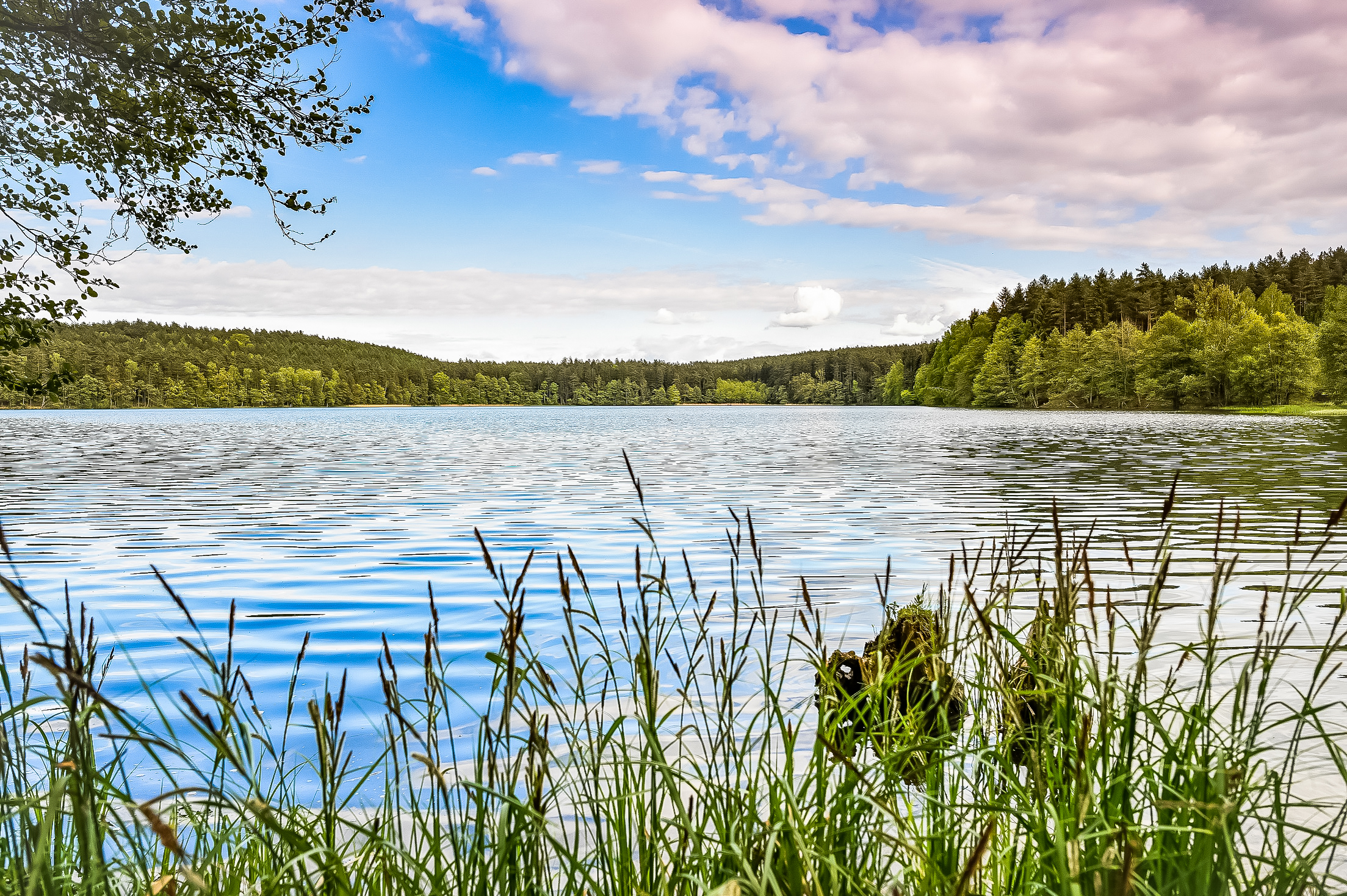
Lake Obłęże
The largest and most popular lakes in the southern part of Słupsk are: Lake Obłęskie and Korzybie., In the season they are guarded by lifeguards, there are campsites, swimming equipment rentals and catering points.
Water skiing and wakeboarding enthusiasts will find at Lake Obłęże an excellent infrastructure for practicing these water sports, a swimming equipment rental, a harbormaster building with a field kitchen, a place for recreation and relaxation, a campsite and overnight accommodation.
HYDRO PLANTS
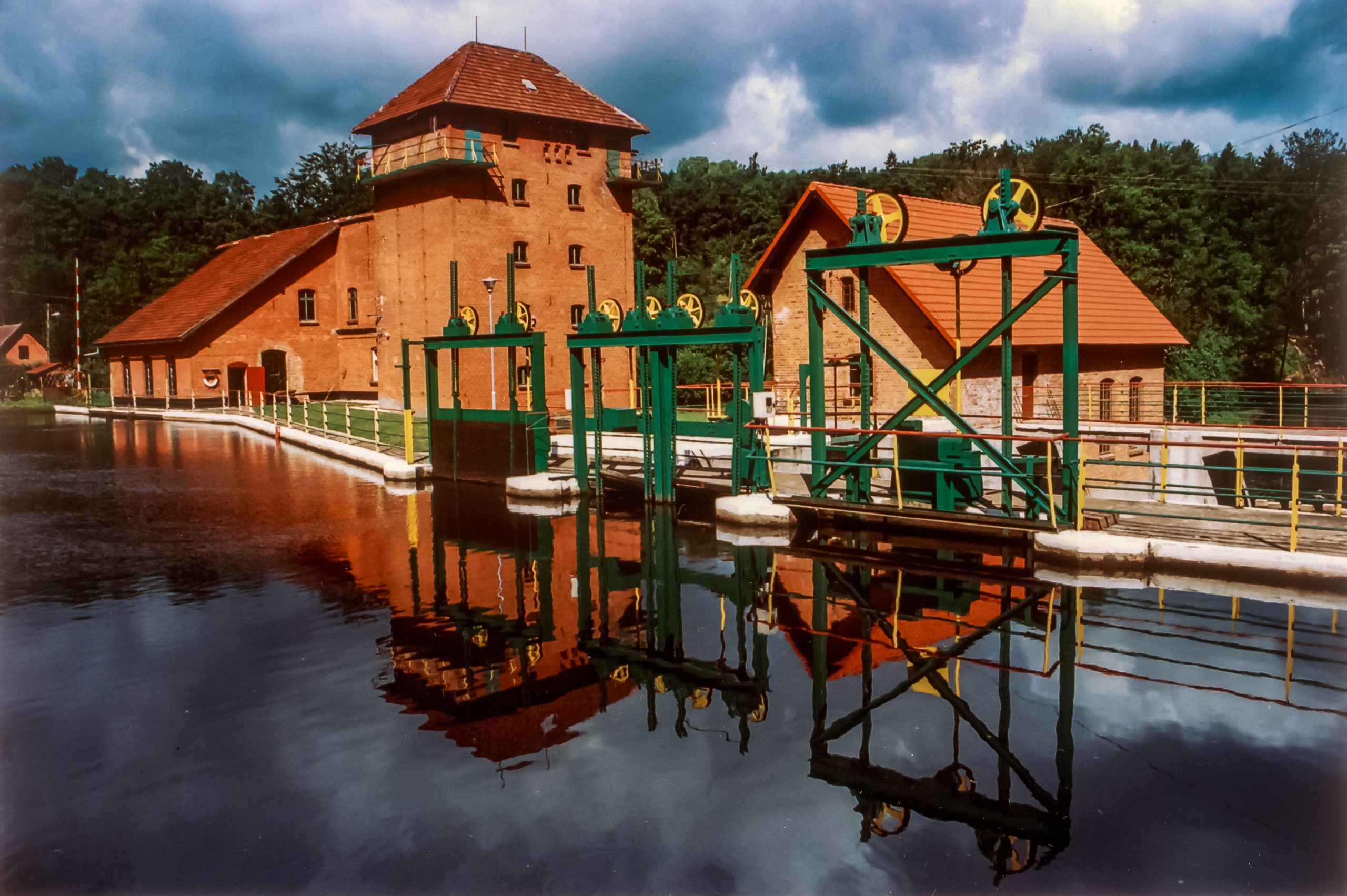
The orography of Słupsk and the river network in the Wieprz, Słupia and Łupawa basins are potential energy resources, , which were used for obtaining electrical current at the turn of the 19th and 20th centuries. Hence, former watermills were replaced with hydro plants, which became a tourist product called the “Trail of the Oldest Hydroelectric Power Plants in Europe”.
There are five power plants on the trail in the Słupia basin: Skarszów Dolny, Krzynia, Strzegomino, Gałąźnia Mała and Struga. All are open to visitors. The tourists consider the hydro plant in Gałąźnia Mała as the most interesting; in addition to operating electrical devices, there is an exhibition presenting the history of hydro plants.
which were used for obtaining electrical current at the turn of the 19th and 20th centuries. Hence, former watermills were replaced with hydro plants, which became a tourist product called the “Trail of the Oldest Hydroelectric Power Plants in Europe”.
There are five power plants on the trail in the Słupia basin: Skarszów Dolny, Krzynia, Strzegomino, Gałąźnia Mała and Struga. All are open to visitors. The tourists consider the hydro plant in Gałąźnia Mała as the most interesting; in addition to operating electrical devices, there is an exhibition presenting the history of hydro plants.
SŁUPIA VALLEY LANDSCAPE PARK
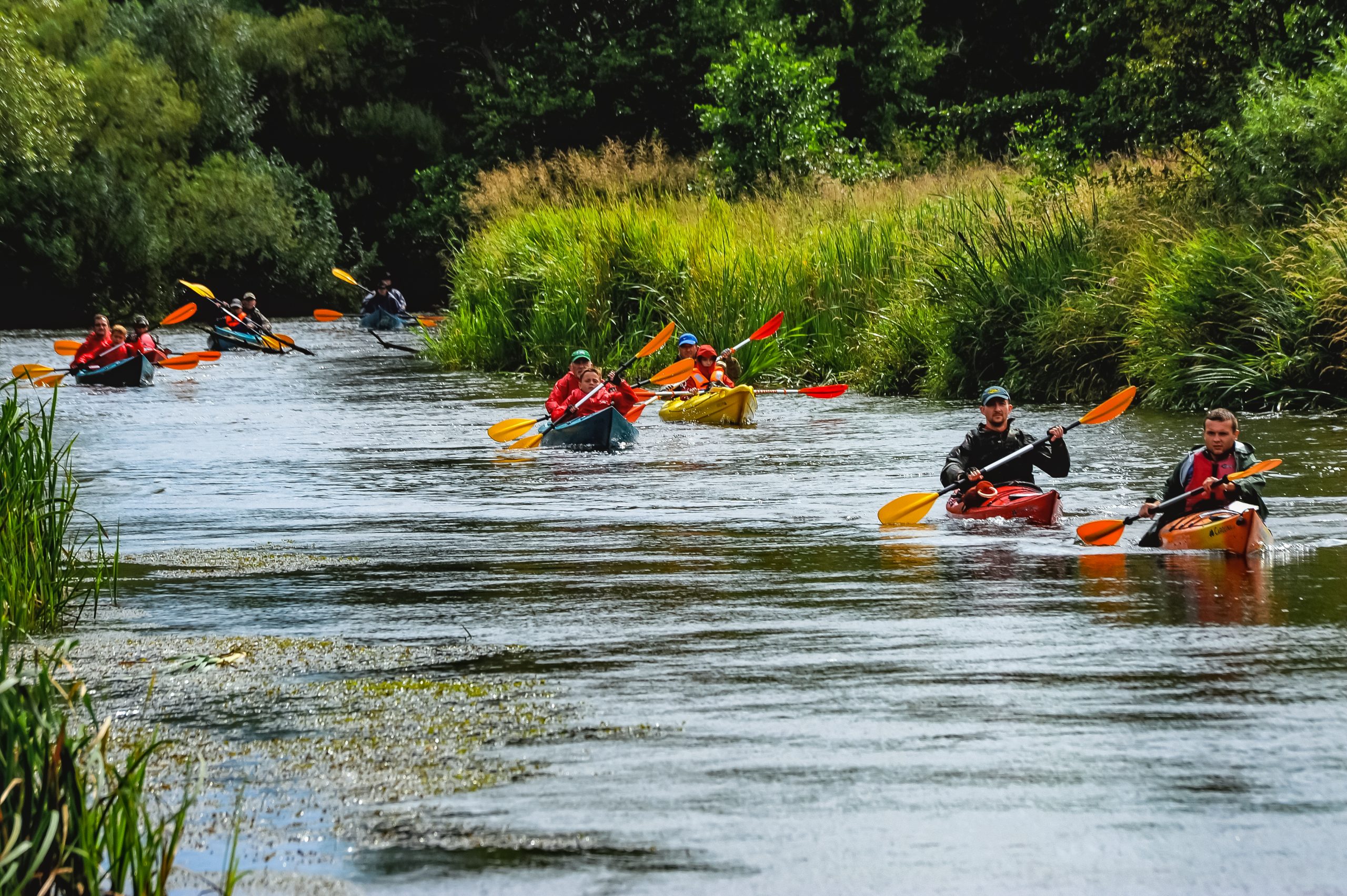
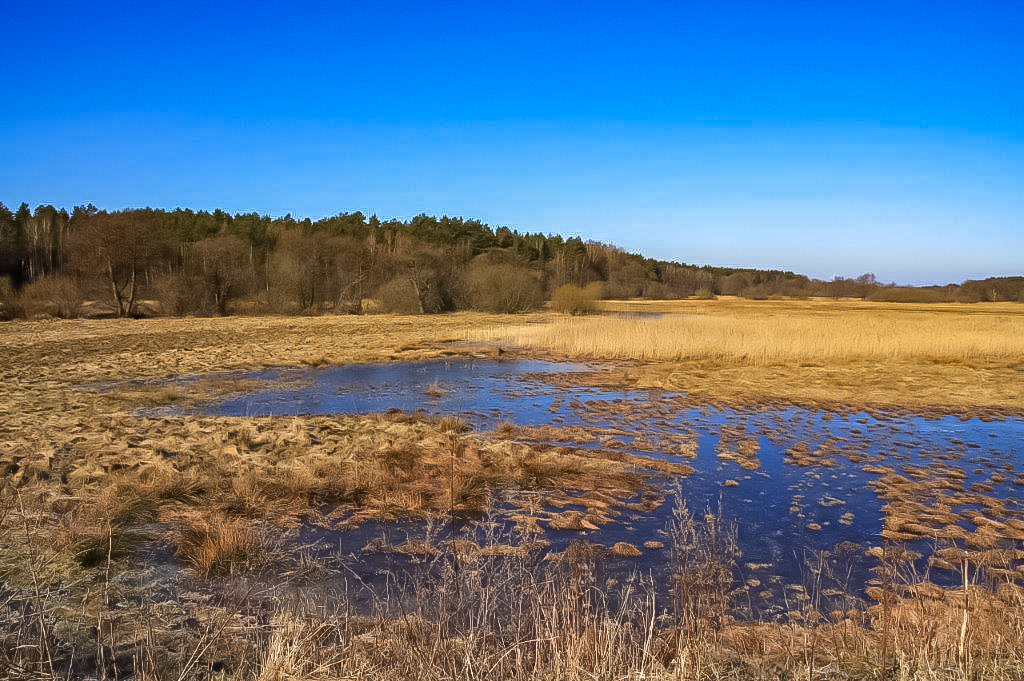
The park (area 37,040 ha, with a buffer zone of 83,170 ha) is the only valley-type park in the Pomeranian Voivodeship, obejmuje obszar, przez który biegnie rzeka Słupia. Urozmaicona rzeźba terenu, piękne krajobrazy i bogata szata roślinna stwarzają doskonałe możliwości do wypoczynku. Do uprawiania turystyki pieszej, rowerowej, konnej i kajakowej zachęcają szlaki turystyczne oraz ścieżki przyrodnicze. Stare elektrownie, kanały i zbiorniki wodne położone w otoczeniu pięknej natury sprawiają, że jest to jeden z najpiękniejszych zakątków powiatu słupskiego.
The rivers in the Słupia Valley Park are clean, cool and oxygenated, which creates a good habitat for brown trout, chub and grayling. From July to autumn, Atlantic salmon and sea trout migrate to spawn upward the Słupia and its tributaries. At this time, catching these species of fish is prohibited.
The abundance of avifauna in the Park involves the presence of 153 species, including as many as 139 comprised with strict protection. Among the animals inhabiting the forests, you can come across herds of deer, wild boar families, foxes and red deer. As in the Słowiński National Park, beavers make increasing appearances here.
